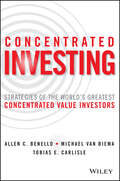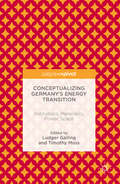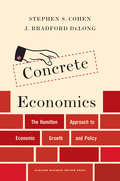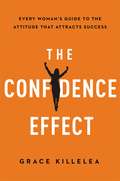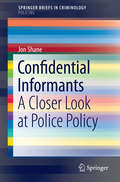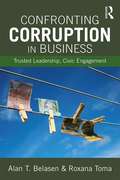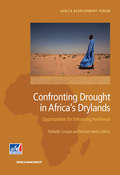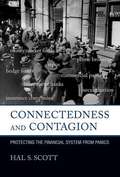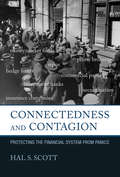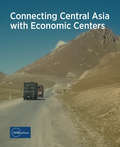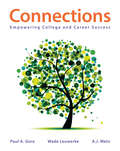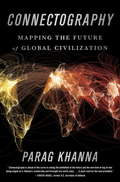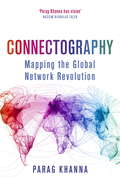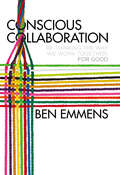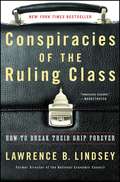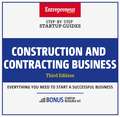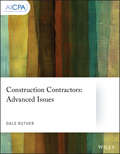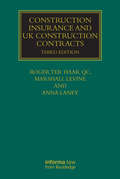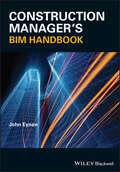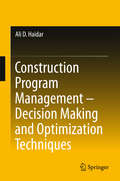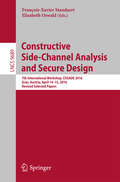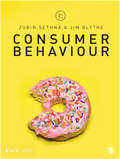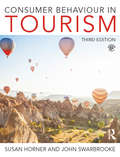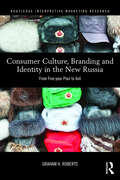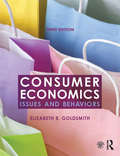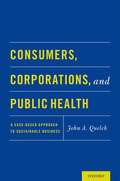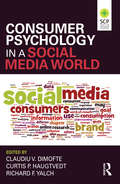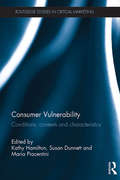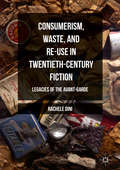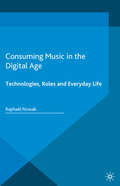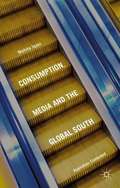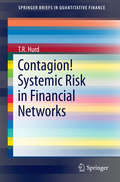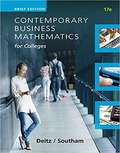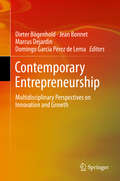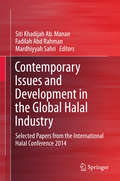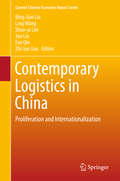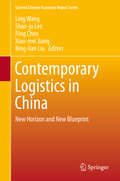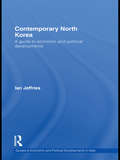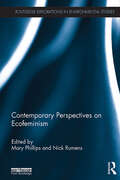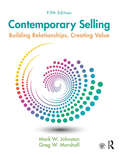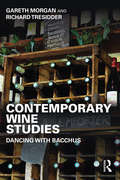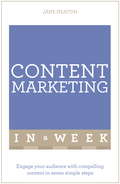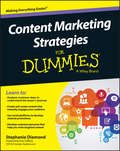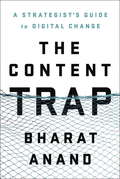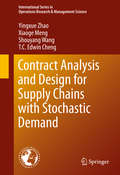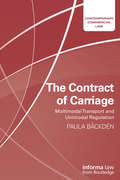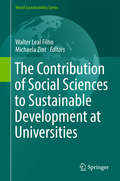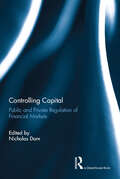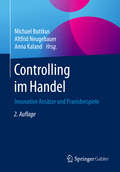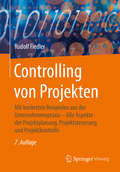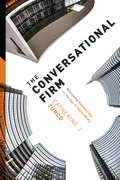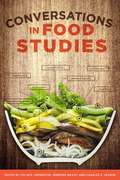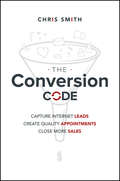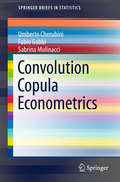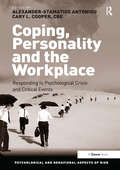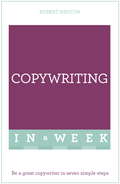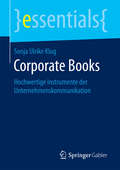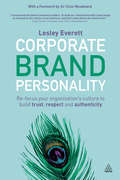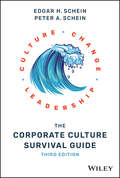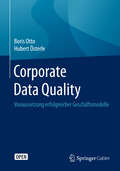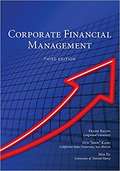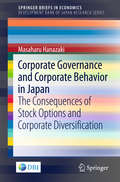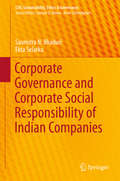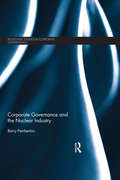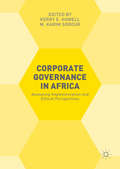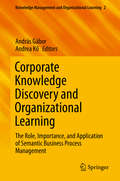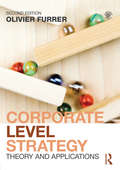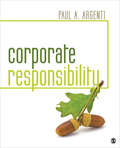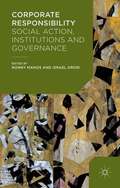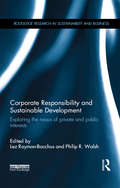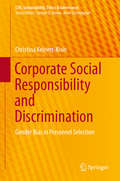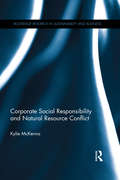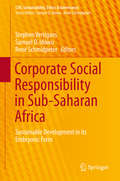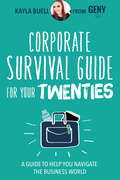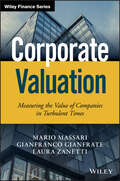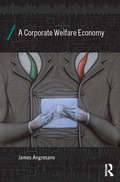- Table View
- List View
Concentrated Investing: Strategies of the World's Greatest Concentrated Value Investors
by Allen C. Benello Michael Van Biema Tobias E. CarlisleDiscover the secrets of the world's top concentrated value investors Concentrated Investing: Strategies of the World's Greatest Concentrated Value Investors chronicles the virtually unknown--but wildly successful--value investors who have regularly and spectacularly blown away the results of even the world's top fund managers. Sharing the insights of these top value investors, expert authors Allen Benello, Michael van Biema, and Tobias Carlisle unveil the strategies that make concentrated value investing incredibly profitable, while at the same time showing how to mitigate risk over time. Highlighting the history and approaches of four top value investors, the authors tell the fascinating story of the investors who dare to tread where few others have, and the wildly-successful track records that have resulted. Turning the notion of diversification on its head, concentrated value investors pick a small group of undervalued stocks and hold onto them through even the lean years. The approach has been championed by Warren Buffett, the best known value investor of our time, but a small group of lesser-known investors has also used this approach to achieve outstanding returns. Discover the success of Lou Simpson, a former GEICO investment manager and eventual successor to Warren Buffett at Berkshire Hathaway Read about Kristian Siem, described as "Norway's Warren Buffett," and the success he has had at Siem Industries Concentrated Investing will quickly have you re-thinking the conventional wisdom related to diversification and learning from the top concentrated value investors the world has never heard of.
Concentration and Power in the Food System: Who Controls What We Eat?
by Philip H. HowardThis book reveals the dominant corporations, from the supermarket to the seed industry, and the extent of their control over markets. It also analyzes the strategies these firms are using to reshape society in order to further increase their power, particularly in terms of their bearing upon the more vulnerable sections of society, such as recent immigrants, ethnic minorities and those of lower socioeconomic status. Yet this study also shows that these trends are not inevitable. Opposed by numerous efforts, from microbreweries to seed saving networks, it explores how such opposition has encouraged the most powerful firms to make small but positive changes.
Conceptualizing Germany's Energy Transition: Institutions, Materiality, Power, Space
by Ludger Gailing Timothy MossThis is the first book to explore ways of conceptualizing Germany's ongoing energy transition. Although widely acclaimed in policy and research circles worldwide, the Energiewende is poorly understood in terms of social science scholarship. There is an urgent need to delve beyond descriptive accounts of policy implementation and contestation in order to unpack the deeper issues at play in what has been termed a 'grand societal transformation. ' The authors approach this in three ways: First, they select and characterize conceptual approaches suited to interpreting the reordering of institutional arrangements, socio-material configurations, power relations and spatial structures of energy systems in Germany and beyond. Second, they assess the value of these concepts in describing and explaining energy transitions, pinpointing their relative strengths and weaknesses and exploring areas of complementarity and incompatibility. Third, they illustrate how these concepts can be applied - individually and in combination - to enrich empirical research of Germany's energy transition.
Concrete Economics
by J. Bradford Delong Stephen S. CohenHistory, not ideology, holds the key to growth.Brilliantly written and argued, Concrete Economics shows how government has repeatedly reshaped the American economy ever since Alexander Hamilton's first, foundational redesign.This book does not rehash the sturdy and long-accepted arguments that to thrive, entrepreneurial economies need a broad range of freedoms. Instead, Steve Cohen and Brad DeLong remedy our national amnesia about how our economy has actually grown and the role government has played in redesigning and reinvigorating it throughout our history. The government not only sets the ground rules for entrepreneurial activity but directs the surges of energy that mark a vibrant economy. This is as true for present-day Silicon Valley as it was for New England manufacturing at the dawn of the nineteenth century.The authors' argument is not one based on abstract ideas, arcane discoveries, or complex correlations. Instead it is based on the facts-facts that were once well known but that have been obscured in a fog of ideology-of how the US economy benefited from a pragmatic government approach to succeed so brilliantly.Understanding how our economy has grown in the past provides a blueprint for how we might again redesign and reinvigorate it today, for such a redesign is sorely needed.
The Condo Book: How to Not Get Burned When Buying and Living in a Home Within a Community Association
by David T. SchwindtAt last a book that guides the reader through the perils and opportunities of buying a home within a community association. Condominiums, townhomes, cooperatives, and single-family homes within a community association share similar issues with respect to financial and governance surprises that may affect your pocketbook and quality of life. Learn how to ask for the right information, ask the right questions, and decide for yourself the best home that reflects your values, lifestyle, and budget—and of course to help avoid a major surprise after purchase. David T. Schwindt, certified public accountant, consultant, and reserve study specialist, brings over thirty years of experience with community associations in an easy-to-understand resource that you will find invaluable in making the right decision for you and your family. Included with each informative chapter are tips, best practices, and ways to create community and harmony within an association.
The Confidence Effect: Every Woman's Guide to the Attitude That Attracts Success
by Grace KilleleaEvery day, talented, hardworking women are passed over for promotions. While it's easy to blame a corporate culture that favors men, seasoned executive Grace Killelea identifies another culprit: a surprising disparity in confidence. Men are prone to overestimate their abilities, while women too often sell themselves short.The Confidence Effect helps women speak out, take risks, and assume leadership positions with assurance. The book moves beyond research and statistics to focus on what's really important: how women can become more confident, one step at a time.Practical strategies show how to turn job competency into the kind of authentic confidence that gets noticed. Women learn to practice the Four Rs of Success--relationships, reputation, results, and resilience--dipping in for tips and tools on how to:Build circles of influenceSeize opportunities they normally avoidLeverage and promote their skillsCultivate executive presenceUse data compellinglyBounce back from setbacksAnd moreWith this powerful new book, women everywhere will find the confidence they need to step off the sidelines onto the playing field--and claim the success they deserve.
Confidential Informants: A Closer Look at Police Policy (SpringerBriefs in Criminology)
by Jon ShaneWhile confidential informants (CI's) can play a crucial role in police investigations, they also have the potential to cause great harm if they are dishonest. The process by which police agencies qualify a CI to work and the strength of agency policy may be the source of the problem. This Brief examines the integrity problem involving CIs in police operations within the United States, provides an overview of pitfalls and problems related to veracity and informant integrity including the difficulties in detecting when a CI is lying, and compares the provisions of actual published police policy to the model CI policy published by the International Association of Chiefs of Police (IACP). The analysis shows a wide divergence between actual police policy and the national standard promulgated by the IACP. The Brief provides policy recommendations for improving use of CIs that can potentially reduce or eliminate integrity problems that can lead to organizational accidents such as wrongful arrests and convictions, injuries or deaths. Some Courts have issued measures to ensure that information received from CIs is reliable by examining sworn testimony and documents related to their work. However, as this Brief explores, this judicial effort arises only after a police operation has taken place, and the use of force - even deadly force--has already been employed. The author proposes integrity testing beforehand, which would allow police to have a greater understanding of a CI's motivation, ability and veracity when conducting law enforcement operations. In addition, there are aspects of police policy that can enhance CI management such as training, supervision and entrapment that can further guard against integrity problems. Although integrity testing is not flawless, it does interpose an additional step in the CI management process that can help guard against wrongful conviction and perjury that harms the judicial process.
Conflict Survival Kit: Tools for Resolving Conflict at Work (Second Edition)
by Daniel B. Griffith Cliff GoodwinTaking a front-line view, The Conflict Survival Kit: Tools for Resolving Conflict at Workfocuses on topics supervisors, team leads and managers need to know to address conflict in organizations. Each chapter succinctly explains conflict theories, frameworks and models, while focusing on important interpersonal and management skills. This classroom text and on-the-job guide presents strategies that can be used immediately in the workplace and provides hands-on practice throughout. Fully updated in this edition, it includes a new section on cultural communication differences, more on mediation, strategies for staying calm during confrontation and a section on managing bullying in the workplace.
Confronting Corruption in Business: Trusted Leadership, Civic Engagement
by Alan T. Belasen Roxana TomaConfronting Corruption in Business focuses on the contextual issues that trigger corruption to give the reader a more thorough understanding of destructive leadership. It provides students with a unique, critical perspective on issues of leadership, corruption, and policy in different countries, industries, and companies. While there isn’t a universally agreed upon definition of corruption in social sciences, it generally refers to efforts to secure wealth or power through misusing public power for private gain. This kind of destructive leadership is typically treated as an anomaly, but this book closes the gap in our understanding by highlighting the wider consequences of this behavior within business, and on an international level. Armed with this understanding, one also learns how to mitigate its causes and consequences. Edited by leading experts, the book includes contributions from scholars with international expertise on leadership, strategy, political science, finance, organizational change, and public policy. It is the first book to focus on corruption on the country level and within business, and students in international business, management, ethics, and leadership classes will find it a valuable read.
Confronting Drought in Africa's Drylands: Opportunities for Enhancing Resilience
by Michael Morris Raffaello CervigniDrylands are at the core of Africa's development challenge. Drylands make up about 43 percent of the region's land surface, account for about 75 percent of the area used for agriculture, and are home to about 50 percent of the population, including a disproportionate share of the poor. Due to complex interactions among many factors, vulnerability in drylands is high and rising, jeopardizing the long-term livelihood prospects for hundreds of millions of people. Climate change, which is expected to increase the frequency and severity of extreme weather events, will exacerbate this challenge. African governments and their partners in the international development community stand ready to tackle the challenges confronting drylands, but important questions remain unanswered about how the task should be undertaken. Do dryland environments contain enough resources to generate the food, jobs, and income needed to support sustainable livelihoods for a fast growing population? If not, can injections of external resources make up the deficit? Or is the carrying capacity of drylands so limited that outmigration should be encouraged? Based on analysis of current and projected future drivers of vulnerability and resilience, the report uses an original modeling framework to identify promising interventions, quantify their likely costs and benefits, and describe the policy trade-offs that will need to be addressed. By 2030, economic growth leading to structural change will allow some of the people living in drylands to transition to non-agriculture based livelihood strategies, reducing their vulnerability. Many others will continue to rely on livestock keeping and crop farming. For the latter group, a number of "best bet ? interventions have the potential to make a significant difference in reducing vulnerability and increasing resilience. This report evaluates the opportunities and challenges associated with these interventions, and it draws a number of conclusions that have important implications for policy making.
Connectedness and Contagion: Protecting the Financial System from Panics
by Hal S. ScottThe Dodd--Frank Act of 2010 was intended to reform financial policies in order to prevent another massive crisis such as the financial meltdown of 2008. Dodd--Frank is largely premised on the diagnosis that connectedness was the major problem in that crisis -- that is, that financial institutions were overexposed to one another, resulting in a possible chain reaction of failures. In this book, Hal Scott argues that it is not connectedness but contagion that is the most significant element of systemic risk facing the financial system. Contagion is an indiscriminate run by short-term creditors of financial institutions that can render otherwise solvent institutions insolvent. It poses a serious risk because, as Scott explains, our financial system still depends on approximately $7.4 to $8.2 trillion of runnable and uninsured short-term liabilities, 60 percent of which are held by nonbanks. Scott argues that efforts by the Federal Reserve, the FDIC, and the Treasury to stop the contagion that exploded after the bankruptcy of Lehman Brothers lessened the economic damage. And yet Congress, spurred by the public's aversion to bailouts, has dramatically weakened the power of the government to respond to contagion, including limitations on the Fed's powers as a lender of last resort. Offering uniquely detailed forensic analyses of the Lehman Brothers and AIG failures, and suggesting alternative regulatory approaches, Scott makes the case that we need to restore and strengthen our weapons for fighting contagion.
Connectedness and Contagion: Protecting the Financial System from Panics
by Hal S. ScottAn argument that contagion is the most significant risk facing the financial system and that Dodd¬Frank has reduced the government's ability to respond effectively.The Dodd–Frank Act of 2010 was intended to reform financial policies in order to prevent another massive crisis such as the financial meltdown of 2008. Dodd–Frank is largely premised on the diagnosis that connectedness was the major problem in that crisis—that is, that financial institutions were overexposed to one another, resulting in a possible chain reaction of failures. In this book, Hal Scott argues that it is not connectedness but contagion that is the most significant element of systemic risk facing the financial system. Contagion is an indiscriminate run by short-term creditors of financial institutions that can render otherwise solvent institutions insolvent. It poses a serious risk because, as Scott explains, our financial system still depends on approximately $7.4 to $8.2 trillion of runnable and uninsured short-term liabilities, 60 percent of which are held by nonbanks.Scott argues that efforts by the Federal Reserve, the FDIC, and the Treasury to stop the contagion that exploded after the bankruptcy of Lehman Brothers lessened the economic damage. And yet Congress, spurred by the public's aversion to bailouts, has dramatically weakened the power of the government to respond to contagion, including limitations on the Fed's powers as a lender of last resort. Offering uniquely detailed forensic analyses of the Lehman Brothers and AIG failures, and suggesting alternative regulatory approaches, Scott makes the case that we need to restore and strengthen our weapons for fighting contagion.
Connecting Central Asia with Economic Centers
by AdbiThis is the final report of the Asian Development Bank Institute study Connecting Central Asia with Economic Centers. The study focuses on the five Central Asian economies: Kazakhstan, the Kyrgyz Republic, Tajikistan, Turkmenistan, and Uzbekistan.The aim of the study is to examine the pattern of economic relations between these economies and major economic centers since Central Asia began its transition to a market economy in the early 1990s, highlighting emerging challenges and exploring their policy implications along the way. The report considers trade ties, foreign direct investment and financial flows, migration and remittances, and institutional cooperation between the Central Asian economies and major economic centers such as those in Asia, the European Union, the Russian Federation, and the United States.
Connections
by Paul A. Gore Wade Leuwerke A. J. MetzAre you looking for a college success resource that speaks to the all aspects of a student's college experience? Connections is an innovative new text that offers the ideal balance of motivation, academics, and life skills. It starts with comprehensive coverage of the topics typically covered in the introductory course but has a unique emphasis on goal-setting, life skills and career planning. When packaged with LaunchPad for Connections, it integrates a state-of-the-art, norm-referenced, student-self assessment of non-cognitive and cognitive skills tool called ACES. Print and digital are uniquely combined for a personalized experience. In every chapter, students are encouraged to take a positive, success-oriented approach to this course - and to life in general - by working to strengthen their strengths, celebrate progress, and use setbacks as opportunities for growth. With an emphasis on self-knowledge, and on building skills for college and career success, Connections empowers students to become self-regulated, collaborative learners - learners who thrive in school, on the job, and in the community.
Connectography: Mapping the Future of Global Civilization
by Parag KhannaFrom the visionary bestselling author of The Second World and How to Run the World comes a bracing and authoritative guide to a future shaped less by national borders than by global supply chains, a world in which the most connected powers--and people--will win.Connectivity is the most revolutionary force of the twenty-first century. Mankind is reengineering the planet, investing up to ten trillion dollars per year in transportation, energy, and communications infrastructure linking the world's burgeoning megacities together. This has profound consequences for geopolitics, economics, demographics, the environment, and social identity. Connectivity, not geography, is our destiny. In Connectography, visionary strategist Parag Khanna travels from Ukraine to Iran, Mongolia to North Korea, Pakistan to Nigeria, and across the Arctic Circle and the South China Sea to explain the rapid and unprecedented changes affecting every part of the planet. He shows how militaries are deployed to protect supply chains as much as borders, and how nations are less at war over territory than engaged in tugs-of-war over pipelines, railways, shipping lanes, and Internet cables. The new arms race is to connect to the most markets--a race China is now winning, having launched a wave of infrastructure investments to unite Eurasia around its new Silk Roads. The United States can only regain ground by fusing with its neighbors into a super-continental North American Union of shared resources and prosperity. Connectography offers a unique and hopeful vision for the future. Khanna argues that new energy discoveries and technologies have eliminated the need for resource wars; ambitious transport corridors and power grids are unscrambling Africa's fraught colonial borders; even the Arab world is evolving a more peaceful map as it builds resource and trade routes across its war-torn landscape. At the same time, thriving hubs such as Singapore and Dubai are injecting dynamism into young and heavily populated regions, cyber-communities empower commerce across vast distances, and the world's ballooning financial assets are being wisely invested into building an inclusive global society. Beneath the chaos of a world that appears to be falling apart is a new foundation of connectivity pulling it together.Advance praise for Connectography"Connectography is ahead of the curve in seeing the battlefield of the future and the new kind of tug-of-war being waged on it. Khanna's scholarship and foresight are world-class. . . . A must-read for the next president."--Chuck Hagel, former U.S. secretary of defense "This bold reframing is an exciting addition to our ongoing debate about geopolitics and the future of globalization."--Dominic Barton, global managing partner, McKinsey & Company "This is probably the most global book ever written. It is intensely specific while remaining broad and wide. Its takeaway is that infrastructure is destiny: Follow the supply lines outlined in this book to see where the future flows."--Kevin Kelly, co-founder, Wired "There's no better guide than Khanna to show us all the possibilities of this new hyperconnected world."--Mathew Burrows, director, Strategic Foresight Initiative at the Atlantic Council, and former counselor, U.S. National Intelligence Council "This book is an invaluable resource for anyone involved in business, science, arts, or any other field."--Mark Mobius, executive chairman, Templeton Emerging Markets Group "A must-read for anyone who wants to understand the future of humanity."--Sandy Pentland, professor, MIT Media Lab
Connectography: Mapping the Global Network Revolution
by Parag KhannaWhich lines on the map matter most?It's time to reimagine how life is organized on Earth. In Connectography, Parag Khanna guides us through the emerging global network civilization in which mega-cities compete over connectivity and borders are increasingly irrelevant. Travelling across the world, Khanna shows how twenty-first-century conflict is a tug-of-war over pipelines and Internet cables, advanced technologies and market access.Yet Connectography also offers a hopeful vision of the future - beneath the chaos of a world that appears to be falling apart, a new foundation of connectivity is pulling it together.
Conscious Collaboration: Re-Thinking The Way We Work Together, For Good
by Ben EmmensWhen collaboration works, the results can be breath-taking! But it doesn't always deliver on its potential. Collaboration has been defined as "an unnatural act practiced by non-consenting adults". And often that's exactly what it is! Some collaboration can be painfully difficult with the result that problems are either ignored or smoothed over until the collaboration falters or disintegrates, or self-interest and personal agendas take over and conflict quickly arises. Collaboration and partnerships work well in the aid sector because they have to - no one body has the resources to solve massive problems on their own. Business often sees the advantages of collaboratively sharing costs without fully recognizing the shift in mindset that is required to take managers with a "winner takes all" worldview and get them performing effectively in a win-win world. Part of the solution lies in bringing consciousness to the workplace and developing it as a core competence. A conscious approach to business relationships, planning, and delivery can enable individuals and organizations to truly think about what they are doing, make changes where needed, and become more effective. It is a particularly effective way of managing the multiple and occasionally conflicting stakeholder objectives inherent in any collaborative project. The author draws on his experience in the aid sector and with non-profit organizations to describe the building blocks that underpin successful collaboration, and inspires us to re-think the way we work together, for good.
Consider Your Calling: Six Questions for Discerning Your Vocation
by Gordon T. SmithCourage and Calling
Conspiracies of the Ruling Class
by Lawrence B. Lindsey<P>An audacious and desperately needed primer on how America's Ruling Class have upended the Constitution and taken over our country--and how we must unite to regain control of our liberty. <P>A Ruling Class have emerged in America against the hopes and designs of our Founding Fathers. Over the last hundred years, they have rejected the Constitution and expanded their own power, slowly at first and now rapidly. <P>These people believe their actions are justified because they think they are smarter than the rest of us--so smart they can run our lives better than we can. But for all the power and resources at their command, they have failed. Miserably. <P>Society has become increasingly unequal, even as we're promised "equality." Our government finances are out of control, our basic infrastructure is broken, and education is unaffordable and mediocre. And yet the Ruling Class think the solution is for us to grant them ever more control. <P>We can stop this--but to do so we must unite. <P>In Conspiracies of the Ruling Class, Lawrence Lindsey lays out his plan for how we can use common sense to change the way our country is run. Finally, here is the truth from a Washington insider about how to reawaken the spirit upon which America was founded, with liberty for every person to pursue his or her own dreams. <P><b>A New York Times Bestseller</b>
The “Conspiracy” of Free Trade
by Marc-William PalenFollowing the Second World War, the United States would become the leading 'neoliberal' proponent of international trade liberalization. Yet for nearly a century before, American foreign trade policy was dominated by extreme economic nationalism. What brought about this pronounced ideological, political, and economic about face? How did it affect Anglo-American imperialism? What were the repercussions for the global capitalist order? In answering these questions, The 'Conspiracy' of Free Trade offers the first detailed account of the controversial Anglo-American struggle over empire and economic globalization in the mid- to late-nineteenth century. The book reinterprets Anglo-American imperialism through the global interplay between Victorian free-trade cosmopolitanism and economic nationalism, uncovering how imperial expansion and economic integration were mired in political and ideological conflict. Beginning in the 1840s, this conspiratorial struggle over political economy would rip apart the Republican Party, reshape the Democratic Party, and redirect Anglo-American imperial expansion for decades to come.
Construction and Contracting Business: Step-By-Step Startup Guide
by Entrepreneur MagazineThe experts at Entrepreneur provide a two-part guide to success. First, find out how to start your own construction or contracting firm doing remodels, new constructions, home additions, and more. Then, master the fundamentals of business startup including defining your business structure, funding, staffing and more.This kit includes: Essential industry and business-specific startup steps with worksheets, calculators, checklists and more Entrepreneur Editors' Start Your Own Business, a guide to starting any business and surviving the first three years Interviews and advice from successful entrepreneurs in the industry Worksheets, brainstorming sections, and checklists Entrepreneur's Startup Resource Kit (downloadable)More about Entrepreneur's Startup Resource KitEvery small business is unique. Therefore, it's essential to have tools that are customizable depending on your business's needs. That's why with Entrepreneur is also offering you access to our Startup Resource Kit. Get instant access to thousands of business letters, sales letters, sample documents and more - all at your fingertips!You'll find the following:The Small Business Legal ToolkitWhen your business dreams go from idea to reality, you're suddenly faced with laws and regulations governing nearly every move you make. Learn how to stay in compliance and protect your business from legal action. In this essential toolkit, you'll get answers to the "how do I get started?" questions every business owner faces along with a thorough understanding of the legal and tax requirements of your business.Sample Business Letters1000+ customizable business letters covering each type of written business communication you're likelyto encounter as you communicate with customers, suppliers, employees, and others. Plus a complete guide to business communication that covers every question you may have about developing your own business communication style.Sample Sales LettersThe experts at Entrepreneur have compiled more than 1000 of the most effective sales letters covering introductions, prospecting, setting up appointments, cover letters, proposal letters, the all-important follow-up letter and letters covering all aspects of sales operations to help you make the sale, generate new customers and huge profits.- See more at: https://bookstore.entrepreneur.com/product/start-your-own-construction-business-2e/#sthash.R827WvTz.dpuf
Construction Contractors: Advanced Issues
by Dale RutherConstruction Contractors: Advanced Issues by Dale Ruther
Construction Insurance and UK Construction Contracts (Construction Practice Series)
by Roger ter Haar Anna Laney Marshall LevineConstruction Insurance and UK Construction Contracts has long been the premier text for legal professionals looking for a combined analysis of construction contracts and their relation to insurance law. In a new and updated third edition, this book continues to provide in-depth commentary and pragmatic advice on all the most important regulations and policies surrounding contracts and insurance in the construction industry. Including brand new chapters on reinsurance and energy products, this book covers subjects such as: Minor, intermediate and major project construction contracts Classes of insurance contract The role of insurance brokers Risks in construction and legal liability Professional indemnity insurance and directors' and officers' liability insurance Bonds and insurance Latent defect insurance Property insurance Health and Safety and Construction Regulations Contract Insurance FIDIC, JCT and NEC 3 regulations PFI/PPP projects in the UK Dispute resolution This book is a vital reference tool and practical guide for lawyers and in-house counsels involved in the construction industry as well as project managers, quantity surveyors, construction contractors, architects and engineers needing advice from an experienced legal perspective.
Construction Manager's BIM Handbook
by John EynonBuilding Information Modelling (BIM) harnesses digital technologies to unlock more efficient methods of designing, creating and maintaining built environment assets, so the Construction Manager's BIM Handbook ensures the reader understands what BIM is, what the UK strategy is and what it means for key roles in the construction team. ensure that all readers understand what BIM and are fully aware of the implications of BIM for them and their organisations provides concise summaries of key aspects of BIM ensure that all readers can begin to adopt this approach in future projects includes industry case studies illustrating the use of BIM on large and small projects
Construction Program Management - Decision Making and Optimization Techniques: Decision Making And Optimization Techniques
by Ali D. HaidarExploring complex and intelligent analytical and mathematical methods, this book examines how different approaches can be used to optimize program management in the construction industry. It presents an in-depth study of the different program management methods, ranging from simple decision-making techniques and statistics analysis to the more complex linear programming and demonstrates how knowledge-base systems and genetic algorithms can be used to optimize resources and meet time, budget and quality criteria. It addresses topics including decision-making principles, planning and scheduling, mathematical forecasting models, optimization techniques programming and artificial intelligence techniques. Providing a valuable resource for anyone managing multiple projects in the construction industry, this book is intended for civil and construction engineering students, project managers, construction managers and senior engineers.
Constructive Side-Channel Analysis and Secure Design: 7th International Workshop, COSADE 2016, Graz, Austria, April 14-15, 2016, Revised Selected Papers (Lecture Notes in Computer Science #9689)
by François-Xavier Standaert Elisabeth OswaldThis book constitutes revised selected papers from the 7th International Workshop on Constructive Side-Channel Analysis and Secure Design, COSADE 2016, held in Graz, Austria, in April 2016. The 12 papers presented in this volume were carefully reviewed and selected from 32 submissions. They were organized in topical sections named: security and physical attacks; side-channel analysis (case studies); fault analysis; and side-channel analysis (tools).
Consumer Behaviour
by Jim Blythe Zubin SethnaPraised for its no nonsense approach to engaging students and conveying key learning outcomes and for striking a good balance between sociological and psychological aspects of consumer behaviour, the new edition now features increased coverage of social media, digital consumption and up-to-date marketing practice. Written from a European perspective, international in its scope and with an array of global international examples and cases from a variety of geographic locations and different industry sectors threaded throughout the text, students' understanding and retention of the subject is encouraged through innovative learning features including: 'how to impress your examiner' boxes - ideas and tips for what an examiner may be looking for to help students get the best possible grades in their assessments. 'consumer behaviour in action' boxes - focus on consumer decisions allowing students to focus on the applications of the concepts and theories underpinning the motivations of consumers - something they are likely to do in their future careers as marketers. 'challenging the status quo' boxes - encouraging students to think outside the box, think critically and exercise their problem solving skills. The book is complimented by a companion website featuring a range of tools and resources for lecturers and students, including PowerPoint slides, multiple choice questions, case studies, interactive glossary, flashcards, multimedia links and selected author videos to make the examples in each chapter come to life. Suitable for Undergraduate students with little or no background knowledge of consumer behaviour.
Consumer Behaviour
by Zubin Sethna Jim BlythePraised for its no nonsense approach to engaging students and conveying key learning outcomes and for striking a good balance between sociological and psychological aspects of consumer behaviour, the new edition now features increased coverage of social media, digital consumption and up-to-date marketing practice. Written from a European perspective, international in its scope and with an array of global international examples and cases from a variety of geographic locations and different industry sectors threaded throughout the text, students’ understanding and retention of the subject is encouraged through innovative learning features including: ‘how to impress your examiner’ boxes - ideas and tips for what an examiner may be looking for to help students get the best possible grades in their assessments. ‘consumer behaviour in action’ boxes – focus on consumer decisions allowing students to focus on the applications of the concepts and theories underpinning the motivations of consumers – something they are likely to do in their future careers as marketers. ‘challenging the status quo’ boxes – encouraging students to think outside the box, think critically and exercise their problem solving skills. The book is complemented by a companion website featuring a range of tools and resources for lecturers and students, including PowerPoint slides, multiple choice questions, case studies, interactive glossary, flashcards, multimedia links and selected author videos to make the examples in each chapter come to life. Suitable for Undergraduate students with little or no background knowledge of consumer behaviour.
Consumer Behaviour in Tourism
by John Swarbrooke Susan HornerNow fully revised and updated, the third edition of this bestselling text provides students with a vital understanding of the nature of tourism and contemporary tourists behaviour in political, social and economic context and how this knowledge can be used to manage and market effectively in a variety of tourism sectors including: tourism operations, tourist destinations, hospitality, visitor attractions, retail travel and transport. This third edition has been updated to include: New material on the impacts of IT on research and marketing communications, the rise and influence of social media and virtual technology, the growth in the interest of sustainable tourism products including slow food, the experience economy and new consumer experiences including fulfilment. New international case studies throughout including growth regions such as the Middle East, Russia, Europe, China, India and Brazil. New companion website including Power point slides and a case archive. Each chapter features conclusions, discussion points and essay questions, and exercises, at the end, to help tutors direct student-centred learning and to allow the reader to check their understanding of what they have read. This book is an invaluable resource for students following tourism courses.
Consumer Culture, Branding and Identity in the New Russia: From Five-year Plan to 4x4 (Routledge Interpretive Marketing Research)
by Graham H.J. RobertsAs shopping has been transformed from a chore into a major source of hedonistic pleasure, a specifically Russian consumer culture has begun to emerge that is unlike any other. This book examines the many different facets of consumption in today’s Russia, including retailing, advertising and social networking. Throughout, emphasis is placed on the inherently visual - not to say spectacular - nature both of consumption generally, and of Russian consumer culture in particular. Particular attention is paid to the ways in which brands, both Russian and foreign, construct categories of identity in order to claim legitimacy for themselves. What emerges is a fascinating picture of how consumer culture is being reinvented in Russia today, in a society which has one, nostalgic eye turned towards the past, and the other, utopian eye, set firmly on the future. Borrowing concepts from both marketing and cultural studies, the approach throughout is interdisciplinary, and will be of considerable interest, to researchers, students and practitioners wishing to gain invaluable insights into one of the most lucrative, and exciting, of today’s emerging markets.
Consumer Economics: Issues and Behaviors
by Elizabeth B. GoldsmithFrom identity theft to product recalls, from what we once thought of as unshakeable institutions to increasing concerns about sustainability, consumer issues are an integral part of modern life. This fully updated third edition of Consumer Economics offers students an accessible and thorough guide to the concerns surrounding the modern consumer and brings to light the repercussions of making uninformed decisions in today's economy. This definitive textbook introduces students to these potential issues and covers other key topics including consumer behavior, personal finance, legal rights and responsibilities, as well as marketing and advertising. Combining theory and practice, students are introduced to both the fundamentals of consumer economics and how to become better-informed consumers themselves. Highlights in this new edition include: New Critical Thinking Projects feature to encourage students to develop their critical thinking skills through analysing consumer issues. Expanded coverage of social media and the impact of social influence on consumers. Revised Consumer Alerts: practical advice and guidance for students to make smart consumer decisions. A new Companion Website with a range of presentation materials and exercises related to each chapter. Fully updated throughout, this textbook is suitable for students studying consumer sciences - what works, what doesn't, and how consumers are changing.
Consumer Health
by Emily C. Boudreau John A. QuelchThe public health footprint associated with corporate behavior has come under increased scrutiny in the last decade, with an increased expectation that private profit not come at the expense of consumer welfare. Consumers, Corporations, and Public Health assembles 17 case studies at the intersection of business and public health to illustrate how each side can inform and benefit the other. Through contemporary examples from a variety of industries and geographies, this collection provides students with an appreciation for the importance of consumer empowerment and consumer behavior in shaping both health and corporate outcomes.
Consumer Psychology in a Social Media World
by Curtis P. Haugtvedt Claudiu V. Dimofte Richard F. YalchConsumer Psychology in a Social Media World seeks to illustrate the relevance of consumer psychology theory and research to understanding the social media world that has rapidly become a key component in the social and economic lives of most individuals. Despite the rapid and widespread adoption of social media by consumers, research focused on individuals’ use thereof and its implications for organizations and society has been limited and published in scattered outlets. This has made it difficult for those trying to get either a quick introduction or an in-depth understanding of the associated issues to locate relevant scientific-based information. The book is organized into five broad sections. The first presents a summary overview of social media, including a historical and cultural perspective. The second section is focused on social media as a modern form of word of mouth, always considered the most impactful on consumers. It also touches upon a motivational explanation for why social media has such a strong and broad appeal. Section three addresses the impact that consumers’ switch to social media as a preferred channel has had on marketers’ branding and promotional efforts, as well as the ways in which consumer involvement can be maintained through this process. Section four takes a methodological perspective on the topic of social media, assessing ways in which big data and consumer research are influenced by novel ways of gathering consumer feedback and gauging consumer sentiment. Finally, section five looks at some consumer welfare and public policy implications, including privacy and disadvantaged consumer concerns. Consumer Psychology in a Social Media World will appeal to those who are involved in creating, managing, and evaluating products used in social media communications. As seen in recent financial and business market successes (e.g., Facebook, Twitter, LinkedIn, Instagram, Pinterest, WhatsApp, etc.), businesses focused on facilitating social media are part of the fastest growing and most valuable sector of today’s economy.
Consumer Vulnerability: Conditions, contexts and characteristics (Routledge Studies in Critical Marketing)
by Kathy Hamilton Susan Dunnett Maria PiacentiniConsumer vulnerability is of growing importance as a research topic for those exploring wellbeing. This book provides space to critically engage with the conditions, contexts and characteristics of consumer vulnerability, which affect how people experience and respond to the marketplace and vice versa. Focussing on substantive, ethical, social and methodological issues, this book brings together key researchers in the field and practitioners who work with vulnerability on a daily basis. Organised into 4 sections, it considers consumer vulnerability and key life stages, health and wellbeing, poverty, and exclusion. Methodologically the chapters draw on qualitative research, employing a variety of methods from interview, to the use of poetry, film and other cultural artefacts. This book will be of interest to marketing and consumer research scholars and students and also to researchers in other disciplines including sociology, public policy and anthropology, and practitioners, policy makers and charitable organisations working with vulnerable groups.
Consumerism, Waste, and Re-Use in Twentieth-Century Fiction: Legacies of the Avant-Garde
by Rachele DiniThis book examines manufactured waste and remaindered humans in literary critiques of capitalism by twentieth-century writers associated with the historical avant-garde and their descendants. Building on recent work in new materialism and waste studies, Rachele Dini reads waste as a process or phase amenable to interruption. From an initial exploration of waste and re-use in three Surrealist texts by Giorgio de Chirico, Andr#65533; Breton, and Mina Loy, Dini traces the conceptualization of waste in the writing of Samuel Beckett, Donald Barthelme, J. G. Ballard, William Gaddis, and Don DeLillo. In exploring the relationship between waste, capitalism, and literary experimentation, this book shows that the legacy of the historical avant-garde is bound up with an enduring faith in the radical potential of waste. The first study to focus specifically on waste in the twentieth-century imagination, this is a valuable contribution to the expanding field of waste studies.
Consuming Music in the Digital Age: Technologies, Roles and Everyday Life (Pop Music, Culture and Identity)
by Raphaël NowakThis book addresses the issue of music consumption in the digital era of technologies. It explores how individuals use music in the context of their everyday lives and how, in return, music acquires certain roles within everyday contexts and more broadly in their life narratives.
Consumption, Media and the Global South: Aspiration Contested
by Mehita IqaniWhat does consumption in the global south signify, and how are its complexities communicated in media discourses? This book looks at the media representation of consumer culture in Africa, China, Brazil and India through case studies ranging from celebrity selfies, to travel websites, news reports and documentary film.
Contagion! Systemic Risk in Financial Networks
by T. R. HurdThis volume presents a unified mathematical framework for the transmission channels for damaging shocks that can lead to instability in financial systems. As the title suggests, financial contagion is analogous to the spread of disease, and damaging financial crises may be better understood by bringing to bear ideas from studying other complex systems in our world. After considering how people have viewed financial crises and systemic risk in the past, it delves into the mechanics of the interactions between banking counterparties. It finds a common mathematical structure for types of crises that proceed through cascade mappings that approach a cascade equilibrium. Later chapters follow this theme, starting from the underlying random skeleton graph, developing into the theory of bootstrap percolation, ultimately leading to techniques that can determine the large scale nature of contagious financial cascades.
The Container Store
by Aldo Sesia Tatiana Sandino Zeynep TonThe Container Store (TCS) is a Texas-based retailer of organization and storage solutions. The company prides itself in taking care of its employees first and its co-founder and CEO Kip Tindell practices Conscious Capitalism. Since it beginnings in 1978, TCS grew to a chain of around 70 stores located in over 20 states by 2013. Tindell believed TCS's employee-first culture and the seven Foundation Principles, which guided the company, were what differentiated the company from other retailers. With plans to grow to 300 stores, TCS went public in late 2013. Since its IPO same store sales have suffered and the company's stock in early 2016 was trading well below its IPO price. As such, the company's culture and Foundation Principles were being put to the test.
Contemporary Business Mathematics for Colleges
by James DeitzPresenting a basic, arithmetic-based approach, CONTEMPORARY BUSINESS MATHEMATICS FOR COLLEGES, 17E uses step-by-step development of concepts, hands-on practice exercises, and real-world applications to effectively prepare students for careers in business. Practical skill-building activities are emphasized throughout as the book progresses, from the most basic to more complex business math topics. Numerous problems and examples are taken from actual businesses. In addition, self-check features such as end-of-section Concept Checks, end-of-chapter Bottom Lines, and end-of-chapter Review Problems enable students to test their understanding before advancing to other topics or assignments.
Contemporary Entrepreneurship: Multidisciplinary Perspectives on Innovation and Growth
by Dieter Bögenhold Jean Bonnet Marcus Dejardin Domingo Garcia Pérez de LemaThis book presents the current state-of-the-art in all major and upcoming areas of entrepreneurship research. Thousands of scholars around the world are currently working to broaden our understanding of the entrepreneurial phenomenon. The disciplines involved are numerous, as are the topics of interest, with substantial efforts to enhance the existing knowledge. This book is specifically designed to facilitate high-level, high-intensity discussions and fruitful exchanges between scholars involved in entrepreneurship research. The articles address a variety of topics ranging from self-employment, technology, growth patterns and job creation, and success and failure rates, to historical, conceptual and comparative international approaches. "This book takes entrepreneurship beyond theindividual, size of the venture, entrepreneurial personality, and looks atentrepreneurship as a long term complex process that is heterogeneous, contentdependent with an emphasis on innovation and growth. A must read forindividuals interested in entrepreneurship, today and in the future, on adomestic and global basis. " - Robert D. Hisrich,Director - Walker Center and Garvin Professor of Global Entrepreneurship,Thunderbird School of Global Management "Entrepreneurship is perhaps not just the most multifaceted but also themost important concept of the modern socio-economic disciplines. This bookmakes an invaluable contribution in this fascinating area: it presents amultifaceted socio-economic examination of the impact of entrepreneurship forgrowth. " - Roy Thurik,Erasmus School of Economics in Rotterdam and Montpellier Business School
Contemporary Issues and Development in the Global Halal Industry: Selected Papers from the International Halal Conference 2014
by Siti Khadijah Ab. Manan Fadilah Abd Rahman Mardhiyyah SahriThis book features more than 50 papers presented at the International Halal Conference 2014, which was held in Istanbul and organised by the Academy of Contemporary Islamic Studies of Universiti Teknologi MARA. It addresses the challenges facing Muslims involved in halal industries in meeting the increasing global demand. The papers cover topics such as halal food, halal pharmaceuticals, halal cosmetics and personal care, halal logistics, halal testing and analysis and ethics in the halal industry. Overall, the volume offers a comprehensive point of view on Islamic principles relating to the halal business, industry, culture, food, safety, finance and other aspects of life. The contributors include experts from various disciplines who apply a variety of scientific research methodologies. They present perspectives that range from the experimental to the philosophical. This volume will appeal to scholars at all levels of qualification and experience who seek a clearer understanding of important issues in the halal industry.
Contemporary Issues in Development Economics (International Economic Association Series)
by Timothy BesleyThis IEA volume brings together a set of essays written by leading authors on themes relevant to the study of economic development. The book covers a range of topics many of which are relevant to policy issues. The contributors bring new insights from empirical research in a range of economies with chapters including discussions of the UN development agenda, fiscal policy in Latin America, poverty data in Africa and Jordan, and monetary policy in South Africa. Contemporary Issues in Development Economics is an essential read for researchers, scholars and policymakers interested in economic development in low- and middle-income countries.
Contemporary Issues in Macroeconomics: Lessons from the Crisis and Beyond (International Economic Association Series)
by Joseph Stiglitz Martin GuzmanIn this edited collection, Joseph Stiglitz and Martin Guzman present a series of studies on contemporary macroeconomic issues. The book discusses a set of key lessons for macroeconomic theory following the recent global financial crisis and explores unconventional monetary policy in a post-crisis world. This volume is divided into five parts. The introduction includes keynote speeches by the Governors of the Bank of Japan and Central Bank of Jordan. Part one focuses on macroeconomic theory for understanding macroeconomic fluctuations and crises. Part two addresses the issue of the measurement of wealth. Part three discusses macroeconomic policies in times of crises. Finally, part four focuses on central banking and monetary policy.
Contemporary Issues in Microeconomics (International Economic Association Series)
by Joseph Stiglitz Martin GuzmanWith contributions from international scholars, this second volume by Joseph Stiglitz and Martin Guzman comprises of theoretical, empirical, and policy-based chapters which carefully utilize theory and data analysis. Part I focuses on the issues of global inequality, poverty measurement and security. Part II turns to the issue of income contingent loans (ICL), where the repayment in any year depends on the annual income of the individual. These loans have proven to be an especially effective way of financing higher education, but there has been experimentation of the use of these loans in several other areas.
Contemporary Issues in Sport Management: A Critical Introduction
by Terri Byers‘Contemporary Issues in Sport Management presents an extensive array of absorbing contemporary issues relevant to managing sport. Internationally recognised scholars have contributed thought-provoking chapters on current global and local issues that are challenging traditional ways of thinking about and delivering sport. This exciting new book is rich in theory and stimulates readers to really think through the associated implications for sport management practice.’ -Tracy Taylor, Professor and Deputy Dean, University of Technology Sydney Business School Contemporary Issues in Sports Management offers a rich and dynamic introduction to the management of sport. An essential companion for all students embarking on a sports management course or module, it draws on research expertise from around the world and integrates these perspectives into engaging and accessible chapters. This book offers: Contemporary and international case studies followed by ‘Tools for analysis’ so students can put the methodology into practice. A range of pedagogical features including learning objectives, learning outcomes and short ‘Thinking points’ Useful websites and further reading at the end of each chapter A discussion of up-to-date issues including corruption in sport, sport policy, doping, athlete transgressions and much more. This book will lead students on a comprehensive exploration of global, national issues, and organizational issues in sport management. The authors encourage critical thought, investigation and the questioning of current practice in order to improve the leadership and management of sport in today’s society. Ideal for Undergraduate students of sport management, sport business, sport policy, sport marketing and sport development.
Contemporary Issues in Sport Management: A Critical Introduction
by Terri Byers'Contemporary Issues in Sport Management presents an extensive array of absorbing contemporary issues relevant to managing sport. Internationally recognised scholars have contributed thought-provoking chapters on current global and local issues that are challenging traditional ways of thinking about and delivering sport. This exciting new book is rich in theory and stimulates readers to really think through the associated implications for sport management practice.' -Tracy Taylor, Professor and Deputy Dean, University of Technology Sydney Business School Contemporary Issues in Sports Management offers a rich and dynamic introduction to the management of sport. An essential companion for all students embarking on a sports management course or module, it draws on research expertise from around the world and integrates these perspectives into engaging and accessible chapters. This book offers: Contemporary and international case studies followed by 'Tools for analysis' so students can put the methodology into practice. A range of pedagogical features including learning objectives, learning outcomes and short 'Thinking points' Useful websites and further reading at the end of each chapter A discussion of up-to-date issues including corruption in sport, sport policy, doping, athlete transgressions and much more. This book will lead students on a comprehensive exploration of global, national issues, and organizational issues in sport management. The authors encourage critical thought, investigation and the questioning of current practice in order to improve the leadership and management of sport in today's society. Ideal for Undergraduate students of sport management, sport business, sport policy, sport marketing and sport development.
Contemporary Logistics in China: Proliferation and Internationalization (Current Chinese Economic Report Series)
by Bing-Lian Liu Ling Wang Shao-Ju Lee Zhi-Lun Jiao Jun Liu Fan QinThis book carries on the ideal of providing a systematic exposition of the logistics development in China to the English-reading community at large in the spirit of the four predecessor volumes, published in previous years. This book is the fifth volume in a series entitled "Contemporary Logistics in China", authored by the researchers in Logistics Center at Nankai University. Specially, the opening chapter of this book presents a synopsis of the intent, the history, the framework, the topical coverage and the train of thought of the sequel in the latest five years. As the previous four volumes, our ultimate aim and desire is to present a timely portrayal of the rapid pace of growth of China's logistics market and the status of its logistics industry's evolution.
Contemporary Logistics in China: New Horizon and New Blueprint (Current Chinese Economic Report Series)
by Bing-Lian Liu Ling Wang Shao-Ju Lee Ping Chen Xiao-Mei JiangThis book is the sixth volume in a series entitled "Contemporary Logistics in China," authored by researchers at the Logistics Center, Nankai University. In the spirit of the five preceding volumes, published annually in previous years, this book carries on the ideal of providing a systematic exposition on the development of logistics in China to the English-speaking community. Specifically, this volume captures China's logistics development at a crucial turning point. On the one hand, it echoes the new horizon advocated by the Government's One-Belt-One-Road Initiative for global cooperation; on the other, it resonates with the new blueprint of implementing the main contents of the 13th Five-year Plan on logistics development. Subjects covered include the macro-factors pertaining to logistics development, region-specific plans, industry-wide transformation, globally oriented moves, and current hot topics. Expositions and analyses on these subjects are based on the latest available sources and statistical data. As with the previous volumes, the ultimate aim of this book is to present a timely portrait of the rapid growth of China's logistics market and the status of its logistics industry's evolution. In so doing, this book offers an in-depth analysis of the critical issues and dilemmas amid the ongoing, dynamic and multi-faceted development, and presents a valuable reference source for interested readers in the academic and professional fields.
Contemporary Marketing (Seventeenth Edition)
by David L. KurtzCONTEMPORARY MARKETING, Seventeenth Edition, is the proven, premier teaching and learning resource for foundational marketing courses. The authors provide thorough coverage of essential marketing principles, exploring all components of the marketing mix, and providing practical guidance to help students prepare for successful marketing careers. This trusted text continues to grow stronger with each groundbreaking new edition, preserving what has made previous editions perennial best-sellers, while adding innovative new features and up-to-date information on current trends, topics, research, and best practices in this ever-evolving field. Because it is so technologically advanced, student-friendly, instructor-supported, and more relevant than ever, CONTEMPORARY MARKETING, Seventeenth Edition, remains in a class by itself.
Contemporary North Korea: A guide to economic and political developments (Guides to Economic and Political Developments in Asia)
by Ian JeffriesThis book provides full details of contemporary economic and political developments in North Korea since late 2005, continuing the overview of developments which were covered in the author’s North Korea: A Guide to Economic and Political Developments (Routledge 2006). Key topics covered include: the succession; family visits; human rights; nuclear capability and intentions; recent initiatives in international relations, and relations with the United States; and adverse economic and social conditions. Overall, the book demonstrates the degree to which North Korea’s international position is changing. This book provides a comprehensive overview of the current political and economic situation in North Korea today, and is an important resource for all those interested in this country’s recent development.
Contemporary Perspectives on Ecofeminism (Routledge Explorations in Environmental Studies)
by Nick Rumens Mary PhillipsWhy is ecofeminism still needed to address the environmental emergencies and challenges of our times? Ecofeminism has a chequered history in terms of its popularity and its perceived value in conceptualizing the relationship between gender and nature as well as feeding forms of activism that aim to confront the environmental challenges of the moment. This book provides a much-needed comprehensive overview of the relevance and value of using eco-feminist theories. It gives a broad coverage of traditional and emerging eco-feminist theories and explores, across a range of chapters, their various contributions and uniquely spans various strands of ecofeminist thinking. The origins of influential eco-feminist theories are discussed including key themes and some of its leading figures (contributors include Erika Cudworth, Greta Gaard, Trish Glazebrook and Niamh Moore), and outlines its influence on how scholars might come to a more generative understanding of the natural environment. The book examines eco-feminism's potential contribution for advancing current discussions and research on the relationships between the humans and more than humans that share our world. This timely volume makes a distinctive scholarly contribution and is a valuable resources for students and academics in the fields of environmentalism, political ecology, sustainability and nature resource management.
Contemporary Selling: Building Relationships, Creating Value
by Greg W. Marshall Mark W. JohnstonContemporary Selling is the only book on the market that combines full coverage of 21st century personal selling processes with a basic look at sales management practices in a way that students want to learn and instructors want to teach. The overarching theme of the book is enabling salespeople to build relationships successfully and to create value with customers. Johnston and Marshall have created a comprehensive, holistic source of information about the selling function in modern organizations that links the process of selling (what salespeople do) with the process of managing salespeople (what sales managers do). A strong focus on the modern tools of selling, such as customer relationship management (CRM), social media and technology-enabled selling, and sales analytics, means the book continues to set the standard for the most up-to-date and student-friendly selling book on the market today. Pedagogical features include:? Mini-cases to help students understand and apply the principles they have learned in the classroom Ethical Dilemma and Global Connection boxes that simulate real-world challenges faced by salespeople and their managers Role Plays that enable students to learn by doing A companion website, featuring an instructor’s manual, PowerPoints, and other tools to provide additional support for students and instructors, will be coming soon. Please contact Routledge's sales team for advance access to the materials.
Contemporary Wine Studies: Dancing with Bacchus
by Gareth Morgan Richard TresidderThe purchase and consumption of wine, whether in hospitality environments or domestic settings, has huge anthropological significance underpinned by a discourse of wine appreciation. It can be seen as a multi-sensory and symbolically status-rich activity framed by historical, social, cultural and ethical discourses. This innovative book offers a critical study of wine from social and cultural perspectives. The field of wine studies spans the spectrum of cultural and technical issues concerning the place of wine in society from viticulture, vinification, labelling, regulation, marketing, purchasing, storage and its final consumption. It combines social history and contemporary questions including the notion of terroir, the nature of protected wine designations, the pricing of wine and the different motivations for buying and consuming wine. It considers wine as a beverage, as an aesthetic exercise and as a marker of status, as well as health implications and legal controls. The title offers a timely contribution into the significance of wine and the role of knowledge, both of which have conceptual and managerial implications in terms of marketing, promotion, consumption and distribution. By offering a holistic and innovative understanding of wine and its consumption, it is a must-read for students and scholars in the fields of wine and social science.
Content Marketing In A Week: Engage Your Audience With Compelling Content In Seven Simple Steps
by Jane HeatonContent marketing just got easierContent marketing is one of today's growing marketing trends following fast on the heels of social media. It is marketing through creating and sharing content that potential customers find relevant, useful and valuable in order to attract, engage, convert and retain them. It's a strategy that requires careful thought, clear objectives and goals, and a deep understanding of your audience. It requires you to reach out to them with well-planned and well-produced content - in all forms and formats, offline as well as online.In this book we take a joined-up look at content marketing, the key principles that underpin it, and what it takes to put it into practice in a consistent and fully formed way. And we provide a practical framework for planning it and executing it successfully - whatever the size of your business or your marketing team. Adopting a content marketing approach is certainly not a short term, quick win tactic. But the chances are it could make a big difference to the effectiveness of your marketing.- Sunday: Adopt a content marketing mindset- Monday: Understand the different types of content- Tuesday: Develop your content marketing strategy- Wednesday: Get started with content planning- Thursday: Create compelling content- Friday: Get ready to share- Saturday: Learn how to measure success
Content Marketing In A Week: Engage Your Audience With Compelling Content In Seven Simple Steps
by Jane Heaton***CIM (CHARTERED INSTITUTE OF MARKETING) BOOK OF THE MONTH MAY 2016***Content marketing just got easierContent marketing is one of today's growing marketing trends following fast on the heels of social media. It is marketing through creating and sharing content that potential customers find relevant, useful and valuable in order to attract, engage, convert and retain them. It's a strategy that requires careful thought, clear objectives and goals, and a deep understanding of your audience. It requires you to reach out to them with well-planned and well-produced content - in all forms and formats, offline as well as online.In this book we take a joined-up look at content marketing, the key principles that underpin it, and what it takes to put it into practice in a consistent and fully formed way. And we provide a practical framework for planning it and executing it successfully - whatever the size of your business or your marketing team. Adopting a content marketing approach is certainly not a short term, quick win tactic. But the chances are it could make a big difference to the effectiveness of your marketing.- Sunday: Adopt a content marketing mindset- Monday: Understand the different types of content- Tuesday: Develop your content marketing strategy- Wednesday: Get started with content planning- Thursday: Create compelling content- Friday: Get ready to share- Saturday: Learn how to measure success
Content Marketing Strategies For Dummies
by Stephanie DiamondDrive your content marketing campaign toward success Blogs and social platforms are all the rage right now-especially for strategists looking to cultivate influence among target audience members through content marketing. Content Marketing Strategies For Dummies explains how you can use content marketing to gain an edge over your competition, even in the most crowded of marketplaces. This timely text introduces you to the Five C Cycle: Company Focus, Customer Experience, Content Creation, Channel Promotion, and Closed-Loop Analysis. The Five C Cycle drives the creation and documentation of a targeted content marketing strategy, and allows you to approach your content marketing campaign with confidence. By helping you determine your company's focus, uncover your customers' experience with data, develop channel promotions across social platforms, create actionable online content, and use closed-loop analysis to build on previous success, this will become your go-to content marketing guide. Content marketing entails creating and curating content online via blog posts, social media platforms, and more. The goal is to acquire and retain customers by creating content that brings value to their lives, and that encourages them to engage with your brand. This easy-to-understand guide will help you do just that. Analyze customer data to better understand your target audience's journey Leverage social platforms, such as Facebook and Twitter, to develop channel promotions Create and curate intelligent, engaging content that leads to action Build upon your previous success with closed-loop analysis Whether you work for a large corporation, are part of a small business, are a solo thought leader, or are an educator, Content Marketing Strategies For Dummies tells you how to gain a critical, competitive advantage through targeted content marketing strategies.
The Content Trap: A Strategist's Guide to Digital Change
by Bharat Anand"As Bharat Anand shows in this eminently readable book, connections are now more important than content."--Daniel H. Pink, author of Drive and To Sell Is Human Harvard Business School Professor of Strategy Bharat Anand presents an incisive new approach to digital transformation that favors fostering connectivity over focusing exclusively on content. Companies everywhere face two major challenges today: getting noticed and getting paid. To confront these obstacles, Bharat Anand examines a range of businesses around the world, from The New York Times to The Economist, from Chinese Internet giant Tencent to Scandinavian digital trailblazer Schibsted, and from talent management to the future of education. Drawing on these stories and on the latest research in economics, strategy, and marketing, this refreshingly engaging book reveals important lessons, smashes celebrated myths, and reorients strategy. Success for flourishing companies comes not from making the best content but from recognizing how content enables customers' connectivity; it comes not from protecting the value of content at all costs but from unearthing related opportunities close by; and it comes not from mimicking competitors' best practices but from seeing choices as part of a connected whole. Digital change means that everyone today can reach and interact with others directly: We are all in the content business. But that comes with risks that Bharat Anand teaches us how to recognize and navigate. Filled with conversations with key players and in-depth dispatches from the front lines of digital change, The Content Trap is an essential new playbook for navigating the turbulent waters in which we find ourselves.Advance praise for The Content Trap"As Bharat Anand shows in this eminently readable book, connections are now more important than content. His insights will bring you several steps closer to understanding the digital revolution and how you can avoid its many perils."--Daniel H. Pink, New York Times bestselling author of Drive and To Sell Is Human"A very smart book--creators, ignore this at your peril. This revolution has been twenty years in the making, and Bharat Anand makes the past (and the future) a lot more clear."--Seth Godin, New York Times bestselling author of Meatball Sundae and Linchpin"Bharat Anand has written the rarest of books, one that combines deep strategic insight with great practical impact. The Content Trap is both a delight to read and the essential book for understanding today's digital revolution. In the process, Anand debunks the conventional wisdom time and time again; his insights are sharp, perceptive, and strikingly original."--David Garvin, C. Roland Christensen Professor of Business Administration, Harvard Business School"'Content is king' may once have been true, but favoring content over connections will only get you dethroned today. In clear and compelling prose, Anand shows us how to lay the strategy groundwork to thrive in an increasingly connected world. Understanding the Content Trap is the true solution to your digital dilemma!"--Barry Nalebuff, Milton Steinbach Professor, Yale School of Management, co-author of Why Not? and Co-opetition, and co-founder of Honest TeaFrom the Hardcover edition.
Contesting Economic and Social Rights in Ireland
by Thomas MurrayThis book presents a political understanding of socio-economic rights by contextualising constitution-makers' and judges' decision-making in terms of Ireland's rich history of people's struggles for justice 'from below' between 1848 and the present. Its theoretical framework incorporates critical legal studies and world-systems analysis. It performs a critical discourse analysis of constitution-making processes in 1922 and 1937 as well as subsequent property, trade union, family and welfare rights case law. It traces the marginalisation of socio-economic rights in Ireland from specific, local and institutional factors to the contested balance of core-peripheral and social relations in the world-system. The book demonstrates the endurance of ideological understandings of state constitutionalism as inherently neutral between interests. Unemployed marches, housing protestors and striking workers, however, provided important challenges and oppositional discourses. Recognising these enduring forms of power and ideology is vital if we are to assess critically the possibilities and limits of contesting socio-economic rights today.
Contract Analysis and Design for Supply Chains with Stochastic Demand (International Series in Operations Research & Management Science #234)
by Shouyang Wang T. C. Edwin Cheng Yingxue Zhao Xiaoge MengThis book is devoted to analysis and design of supply chain contracts with stochastic demand. Given the extensive utilization of contracts in supply chains, the issues concerning contract analysis and design are extremely important for supply chain management (SCM), and substantial research has been developed to address those issues over the past years. Despite the abundance of classical research, new research needs to be conducted in response to new issues emerging with the recent changing business environments, such as the fast-shortening life cycle of product and the increasing globalization of supply chains. This book addresses these issues, with the intention to present new research on how to apply contracts to improve SCM. Contract Analysis and Design for Supply Chains with Stochastic Demand contains eight chapters and each chapter is summarized as follows: Chapter 1 provides a comprehensive review of the classical development of supply chain contracts. Chapter 2 examines the effects of demand uncertainty on the applicability of buyback contracts. Chapter 3 conducts a mean-risk analysis for wholesale price contracts, taking into account contracting value risk and risk preferences. Chapter 4 studies the optimization of product service system by franchise fee contracts in the service-oriented manufacturing supply chain with demand information asymmetry. Chapter 5 develops a bidirectional option contract model and explores the optimal contracting decisions and supply chain coordination issue with the bidirectional option. Chapter 6 addresses supply chain options pricing issue and a value-based pricing scheme is developed for the supply chain options. With a cooperative game theory approach, Chapter 7 explores the issues concerning supply chain contract selection/implementation with the option contract under consideration. Chapter 8 concludes the book and suggests worthy directions for future research.
The Contract of Carriage: Multimodal Transport and Unimodal Regulation (Contemporary Commercial Law)
by Paula BäckdénThe Contract of Carriage: Multimodal Transport and Unimodal Regulation provides a new perspective on how to approach the question of multimodal transport regulation regarding liability for goods carried. Unlike previous literature, which has approached the issue of applicability from a strict interpretation-of-the-convention angle, this book will analyse the issue from a law of contracts perspective. If goods are damaged during international transport, the carrier’s liability is governed by rules laid down in international conventions, such as the CMR convention, the Hague–Visby Rules and the Montreal Convention. Such rules apply to certain modes of transport, to contracts for unimodal carriage. When goods are carried under a multimodal contract of carriage, which provides for carriage by more than one mode of transport, the question is whether these rules are applicable to transport under multimodal contracts of carriage. This book investigates the rules of carrier’s liability applicable to unimodal transport, and whether these rules are applicable to carriage under multimodal contracts of carriage, with focus on the actual contract of carriage. This unique text will be of great interest to students, academics, industry professionals, and legal practitioners alike.
The Contribution of Social Sciences to Sustainable Development at Universities
by Walter Leal Filho Michaela ZintThis volume is the first of its kind to presentcontemporary, state-of-the-art examples of how social science theories, models,and findings can advance all aspects of campus sustainability, an area that hasso far been largely neglected. The individual chapters reflect the broaddiversity of research on sustainable campus development conducted within andacross basic and applied social science disciplines, drawing on a range ofmethods and case studies from around the world. Institutions of higher educationhave been among the leading promoters of sustainable development. However,efforts to transition to sustainability have been largely dominated bytechnological "solutions" and universities and colleges are increasinglyrecognizing that this transition cannot be achieved without attention to thehuman dimension. Administrators, campus sustainability officers and otheruniversity staff, faculty members and students, as well as alumni and externalconstituents all help to shape which sustainability innovations and initiativesare considered and pursued, and their participation determines the ultimatesuccess of sustainability efforts. The book's individual contributionsillustrate how the social sciences can broaden visions of what may be possible,identify the advantages and disadvantages of different instrumental andemancipator approaches, evaluate interventions' effectiveness, and offerprocesses for learning from mistakes and successes in ways that supportcontinuous advances toward sustainability. Given that the majority of socialscience research stems from universities, the level of trust in theseinstitutions, and their mission to develop societal leaders, higher educationinstitutions are ideally suited for testing, assessing and modeling the socialinnovations needed to achieve sustainability on campuses and beyond.
Controlled Synthesis of Pt-Ni Bimetallic Catalysts and Study of Their Catalytic Properties (Springer Theses)
by Yuen WuThis thesis focuses on the controlled synthesis of Pt-Ni bimetallic nanoparticles and the study of their catalytic properties. It discusses in detail the nucleation mechanism and the growth process of bimetallic systems, which is vital for a deeper understanding of the design of bimetallic catalysts. The author presents four pioneering studies: (1) syntheses of water-soluble octahedral, truncated octahedral, and cubic Pt-Ni nanocrystals and the study of their structure-activity relationship in model hydrogenation reactions; (2) a strategy for designing a concave Pt-Ni alloy using controllable chemical etching; (3) defect-dominated shape recovery of nanocrystals, which is a new synthesis strategy for trimetallic catalysts; (4) a sophisticated construction of Au islands on Pt−Ni, which is an ideal trimetallic nanoframe catalyst. This thesis inspires researchers working in materials, catalysis as well as other interdisciplinary areas.
Controlling Capital: Public and Private Regulation of Financial Markets
by Nicholas DornControlling Capital examines three pressing issues in financial market regulation: the contested status of public regulation, the emergence of ‘culture’ as a proposed modality of market governance, and the renewed ascendancy of private regulation. In the years immediately following the outbreak of crisis in financial markets, public regulation seemed almost to be attaining a position of command – the robustness and durability of which is explored here in respect of market conduct, European Union capital markets union, and US and EU competition policies. Subsequently there has been a softening of command and a return to public-private co-regulation, positioned within a narrative on culture. The potential and limits of culture as a regulatory resource are unpacked here in respect of occupational and organisational aspects, stakeholder connivance and wider political embeddedness. Lastly the book looks from both appreciative and critical perspectives at private regulation, through financial market associations, arbitration of disputes and, most controversially, market ‘policing’ by hedge funds. Bringing together a distinguished group of international experts, this book will be a key text for all those concerned with issues arising at the intersection of financial markets, law, culture and governance.
Controlling im Handel: Innovative Ansätze und Praxisbeispiele
by Michael Buttkus Altfrid Neugebauer Anna KalandDie Neuauflage dieses Werkes hat nicht nur umfangreiche Aktualisierungen erfahren. Vielmehr erlebt es durch zwei neue Beitr#65533;ge eine wertvolle und interessante Erweiterung. Im zweiten Teil des Buches zum Thema Steuerungsmodelle wird durch einen neuen Beitrag der zunehmenden Bedeutung der Digitalisierung Rechnung getragen. Klassische Gesch#65533;ftsmodelle sind im Wandel, mit ihnen ver#65533;ndern sich die Anforderungen an die Unternehmenssteuerung und stellen Unternehmer vor neue Herausforderungen. Der Beitrag zum ,,Controlling von Multichannel Gesch#65533;ftsmodellen" greift diese Herausforderungen auf und entwickelt L#65533;sungskonzepte f#65533;r das Controlling von Gesch#65533;ftsmodellen, welche einer Multichannel Strategie folgen.
Controlling von Projekten: Mit konkreten Beispielen aus der Unternehmenspraxis – Alle Aspekte der Projektplanung, Projektsteuerung und Projektkontrolle
by Rudolf FiedlerProfitieren Sie von den umfangreichen Praxisbeispielen und der zuverlässigen Gesamtsicht auf alle Aspekte des Projektcontrollings. So bauen Sie ein wirkungsvolles Projektcontrolling auf und integrieren es in das Projektmanagement. Nutzen Sie praxiserprobte und fortschrittliche Instrumente und Methoden, z. B. das Risikocontrolling, die Projekt-Scorecard und die Earned Value-Analyse. Wegweisend für die konkrete Projektarbeit und die Realisierung eines strategisch ausgerichteten Projektcontrollings. "Controlling von Projekten" ist in kurzer Zeit zu Recht ein "Klassiker" geworden. " www. projektmagazin. de, 01/2005
Convention Sales and Services,
by James R. AbbeyEach chapter opens with an insightful analysis of the chapter subject by outstanding practitioners in the meetings industry. This Ninth Edition provides even more comprehensive and up-to-date information-as well as additional features such as Internet Exercises, More Online boxes and Worth Watching video boxes.
Convergent Media and Privacy (Palgrave Global Media Policy and Business)
by Tim DwyerA lot of personal data is being collected and stored as we use our media devices for business and pleasure in mobile and online spaces. This book helps us contemplate what a post-Facebook or post-Google world might look like, and how the tensions within capitalist information societies between corporations, government and citizens might play out.
The Conversational Firm: Rethinking Bureaucracy in the Age of Social Media
by Catherine J TurcoA fast-growing social media marketing company, TechCo encourages all of its employees to speak up. By promoting open dialogue across the corporate hierarchy, the firm has fostered a uniquely engaged workforce and an enviable capacity for change. Yet the path hasn't always been easy. TechCo has confronted a number of challenges, and its experience reveals the essential elements of bureaucracy that remain even when a firm sets out to discard them. Through it all, TechCo serves as a powerful new model for how firms can navigate today's rapidly changing technological and cultural climate.Catherine Turco was embedded within TechCo for ten months. The Conversational Firm is her ethnographic analysis of what worked at the company and what didn't. She offers multiple lessons for anyone curious about the effect of social media on the corporate environment and adds depth to debates over the new generation of employees reared on social media: Millennials who are carrying their technological habits and expectations into the workplace.Marshaling insights from cultural and economic sociology, organizational theory, economics, technology studies, and anthropology, The Conversational Firm offers a nuanced analysis of corporate communication, control, and culture in the social media age.
The Conversational Firm: Rethinking Bureaucracy in the Age of Social Media (The Middle Range Series)
by Catherine TurcoA fast-growing social media marketing company, TechCo encourages all of its employees to speak up. By promoting open dialogue across the corporate hierarchy, the firm has fostered a uniquely engaged workforce and an enviable capacity for change. Yet the path hasn't always been easy. TechCo has confronted a number of challenges, and its experience reveals the essential elements of bureaucracy that remain even when a firm sets out to discard them. Through it all, TechCo serves as a powerful new model for how firms can navigate today's rapidly changing technological and cultural climate.Catherine J. Turco was embedded within TechCo for ten months. The Conversational Firm is her ethnographic analysis of what worked at the company and what didn't. She offers multiple lessons for anyone curious about the effect of social media on the corporate environment and adds depth to debates over the new generation of employees reared on social media: Millennials who carry their technological habits and expectations into the workplace. Marshaling insights from cultural and economic sociology, organizational theory, economics, technology studies, and anthropology, The Conversational Firm offers a nuanced analysis of corporate communication, control, and culture in the social media age.
Conversations in Food Studies
by Colin R. Anderson Jennifer Brady Charles Z. Levkoe Mustafa Koç Mary A. Beckie Eva A. Bogdan Mark Bomford Jennifer A. Braun Samara Brock Robyn Bunn Kirsten Valentine Cadieux Chantal Clement Anais Detolle Arthur Green Ankit Gupta Robert Jennings Josee Johnson Emily Huddart Kennedy Ahmed Khan Mustafa Koc Keith Lee Kristen Lowitt Wanda Martin Victoria Millious Phil Mount Erika Mundel Alan Nash Seriy Polyakov Keren Rideout Steffanie Scott Tammara Soma Cathryn Sprague Jennifer Sumner David Szanto Lani Trenouth Penny Van Esterik Matt Ventresca Cassie Wever Carmen Wong Konstantinos ZougrisFew things are as important as the food we eat. "Conversations in Food Studies" demonstrates the value of interdisciplinary research through the cross-pollination of disciplinary, epistemological, and methodological perspectives. Widely diverse essays, ranging from the meaning of milk, to the bring-your-own-wine movement, to urban household waste, are the product of collaborating teams of interdisciplinary authors. Readers are invited to engage and reflect on the theories and practices underlying some of the most important issues facing the emerging field of foodstudies today. Conversations in Food Studies brings to the table thirteen original contributions organized around the themes of representation, governance, disciplinary boundaries, and, finally, learning through food. This collection offers an important and groundbreaking approach to food studies as it examines and reworks the boundaries that have traditionally structured the academy and that underlie much of food studies literature.
The Conversion Code: Capture Internet Leads, Create Quality Appointments, Close More Sales
by Chris Smith"If you need more traffic, leads and sales, you need The Conversion Code."Neil Patel co-founder Crazy Egg"We've helped 11,000+ businesses generate more than 31 million leads and consider The Conversion Code a must read."Oli Gardner co-founder Unbounce"We'd been closing 55% of our qualified appointments. We increased that to 76% as a direct result of implementing The Conversion Code."Dan Stewart CEO Happy Grasshopper"The strategies in The Conversion Code are highly effective and immediately helped our entire sales team. The book explains the science behind selling in a way that is simple to remember and easy to implement." Steve Pacinelli CMO BombBombCapture and close more Internet leads with a new sales script and powerful marketing templatesThe Conversion Code provides a step-by-step blueprint for increasing sales in the modern, Internet-driven era. Today's consumers are savvy, and they have more options than ever before. Capturing their attention and turning it into revenue requires a whole new approach to marketing and sales. This book provides clear guidance toward conquering the new paradigm shift towards online lead generation and inside sales. You'll learn how to capture those invaluable Internet leads, convert them into appointments, and close more deals. Regardless of product or industry, this proven process will increase both the quantity and quality of leads and put your sales figures on the rise.Traditional sales and marketing advice is becoming less and less relevant as today's consumers are spending much more time online, and salespeople are calling, emailing, and texting leads instead of meeting them in person. This book shows you where to find them, how to engage them, and how to position your company as the ideal solution to their needs. Engage with consumers more effectively online Leverage the strengths of social media, apps, and blogs to capture more leads for less money Convert more Internet leads into real-world prospects and sales appointments Make connections on every call and learn the exact words that close more sales The business world is moving away from "belly-to-belly" interactions and traditional advertising. Companies are forced to engage with prospective customers first online—the vast majority through social media, mobile apps, blogs, and live chat—before ever meeting in person. Yesterday's marketing advice no longer applies to today's tech savvy, mobile-first, social media-addicted consumer, and the new sales environment demands that you meet consumers where they are and close them, quickly. The Conversion Code gives you an actionable blueprint for capturing Internet leads and turning them into customers.
Convolution Copula Econometrics (SpringerBriefs in Statistics)
by Umberto Cherubini Sabrina Mulinacci Fabio GobbiThis book presents a novel approach to time series econometrics, which studies the behavior of nonlinear stochastic processes. This approach allows for an arbitrary dependence structure in the increments and provides a generalization with respect to the standard linear independent increments assumption of classical time series models. The book offers a solution to the problem of a general semiparametric approach, which is given by a concept called C-convolution (convolution of dependent variables), and the corresponding theory of convolution-based copulas. Intended for econometrics and statistics scholars with a special interest in time series analysis and copula functions (or other nonparametric approaches), the book is also useful for doctoral students with a basic knowledge of copula functions wanting to learn about the latest research developments in the field.
Coping, Personality and the Workplace: Responding to Psychological Crisis and Critical Events (Psychological and Behavioural Aspects of Risk)
by Cary L. Cooper Alexander-Stamatios AntoniouHow an individual responds to crises and critical incidents at work, both immediately and subsequent to the event, is heavily influenced both by personality characteristics and their use of coping strategies. These can, in turn, be affected by levels of education, gender and even the profession within which the individual is working. Coping, Personality and the Workplace offers theory, research and practice on our ability to cope with dangerous situations, critical incidents or other work crises. The chapters include perspectives on social and health habits and risks; gender and age differences as well as a range of different sources of threat: financial, psychological and physical; those within and outside the individual’s control; immediate and chronic. For organizations, this collection provides help and advice to build into employee safety and support programmes; for policy makers, a sense of the emerging sources of risk related to occupational health and for researchers, an anthology of original applied research from some of the leading authors in three continents.
Copywriting In A Week: Be A Great Copywriter In Seven Simple Steps
by Robert Ashton Rob AshtonGreat copywriting just got easierIt's strange to think that there was a time when only the privileged few could read or write. The rest of us relied on the spoken word. Storytelling was used to pass knowledge on from one generation to the next. Now, most of us are literate and use the written word to gather information and inform our decision making. Increasingly we do this online, with social media and messaging enabling rapid, spontaneous global communication. But rather than freeing us from the need for clear, effective written communication, it actually makes good communication even more important. The less we communicate face to face, the greater the opportunity for misunderstandings. Of course, all writing communicates your message to people you cannot see and may never meet. It means you can influence more widely; it also means you must take care not to make assumptions aboutyour reader, especially those who see your public postings. Successful copywriting is constructed from carefully selected words, each with a clear purpose. It is written to prompt feelings, thoughts or actions. It is clear, concise and at times comforting. It is also comprehensible, even to those not yet confident users of your language. Reading this book, and following the techniques it introduces, will make you a more effective writer. Expertise in grammar is not needed as all the necessary jargon is simply defined and, anyway, some forms of business writing deliberately ignorerules. This book is for people who want to write for results. Each of the seven chapters in Copywriting In A Week covers a different aspect:- Sunday: Focusing your message- Monday: Using layout, pictures and colour to make words memorable- Tuesday: Writing effective letters- Wednesday: Making advertising work for you- Thursday: Communicating clearly with the media- Friday: Preparing promotional print- Saturday: Composing proposals and presentation visuals
Corporate Books: Hochwertige Instrumente der Unternehmenskommunikation (essentials)
by Sonja Ulrike KlugDieser Leitfaden führt durch alle Entwicklungsstadien von Unternehmensbüchern und zeigt, worauf es ankommt. Die Autorin erläutert das spezielle Vorgehen bei der Planung, Realisierung und Vermarktung von Corporate Books als Premium-Instrumenten der Unternehmenskommunikation, damit ihre Vorteile ausgeschöpft werden können. Unternehmensbücher erhöhen den Bekanntheitsgrad, stärken die Markenidentität, dienen als Zugpferd für Kampagnen und unterstreichen den Expertenstatus für ein Thema. Sie können von Konzernen, Mittelständlern, Kleinunternehmern und Solopreneuren gleichermaßen eingesetzt werden. Corporate Books wirken langfristig und beeinflussen die Wahrnehmung eines Unternehmens durch die Öffentlichkeit positiv.
Corporate Brand Personality
by Lesley EverettCorporate Brand Personality addresses the increasing need for organizations to refocus and realign their corporate culture in order to compete in a business world that demands trust, respect and strong values. Moving beyond simply how products are marketed and perceived, it shows the reader how to lead and engage people at every level within the organization to ensure consistent engagement with brand values. Including practical models to show how corporate culture and values can be managed and improved, Corporate Brand Personality also provides real examples and case studies from the Marriott Hotel Group and Water Wellbeing Group among others that show how people's behaviours can deeply affect brand reputation through all areas of the business. Incorporating a complete strategy from start to finish, this book will help the reader build visible leadership, project an authentic brand image and reinforce their company's values.
Corporate China 2.0: The Great Shakeup
by Qiao LiuThis book argues that that the rise of great firms - those with sustainable high return on invested capital (ROIC) - will lay the foundation for China's successful economic transformation. Drawn from the author's research on corporate finance and the Chinese economy, the author maintains that being big could be easy but means little for corporate China, especially in the context of China's transition from an investment-led economy to an efficiency-driven one. The work discusses both internal and external impediments that lead to lack of great companies in China and suggests institutional conditions which foster the rise of great companies in China, including, reversing the government's obsession with GDP, reforming the financial system, and promoting entrepreneurship. Policy makers, investors, corporate executives, and MBA students and scholars will appreciate case studies of Huawei, Alibaba, Xiaomi, and Lenovo, among others, that illustrate the endeavors made by Chinese entrepreneurs at the grassroots level and highlight what makes successful companies in China.
The Corporate Culture Survival Guide (J-b Warren Bennis Ser. #158)
by Edgar H. Schein Peter A. ScheinEffective, sustainable cultural change requires evolution, not disruption The Corporate Culture Survival Guide is the essential primer and practical guide every organization needs. Corporate culture pioneer Edgar H. Schein breaks the concept of 'culture' down into real terms, delving into the behaviors, values, and shared assumptions that define it, and explains why culture is the central factor in an organization's success—or failure. This new third edition is designed specifically for practitioners needing to apply these practices in real-world settings, and has been updated with new coverage of globalization, technology, and managerial competencies. You'll learn how to get past subconscious bias to assess whether or not your existing culture truly serves your organization, and how to introduce change and manage the change process over time for a best-case-scenario outcome. Case studies illustrate successful change in real companies, providing models and setting the bar for dismantling dysfunctional cultures. Corporate culture begins with the founder, and evolves—or not—over time. Is your culture working for or against your organization? How can it be optimized? This book separates the truth from the nonsense to provide real-world guidance on initiating and managing cultural change. Understand when to assess your culture, and how to do it objectively Learn how cultures evolve and change over time, for better or worse Discover the reality of multiculturalism amidst the rise of globalization Evolve your culture to more effectively serve your organization Each of us is a part of many cultures—what you do, where you live, where you grew up, what you enjoy, how you live; in the workplace, many different people with many different cultures come together toward a common goal—will these cultures clash or synergize? The Corporate Culture Survival Guide shows you how to create an overarching corporate culture that gets everyone on the same page to drive your organization's success.
Corporate Data Quality: Voraussetzung erfolgreicher Geschäftsmodelle
by Boris Otto Hubert ÖsterleDaten sind die strategische Ressource des 21. Jahrhunderts. Es findet kein Gesch#65533;ftsprozess, keine Kommunikation zwischen Gesch#65533;ftspartnern, keine Wertsch#65533;pfung statt, ohne dass die involvierten Personen, Maschinen und IT-Systeme Daten nutzen, erzeugen oder ver#65533;ndern. Trends wie die Digitalisierung, Industrie 4. 0 und Social Media tragen ebenfalls dazu bei, dass Datenmanagement zu einer Kernkompetenz f#65533;r erfolgreiche Unternehmen dieser Zeit geworden ist. Damit Daten ihren ganzen Wert entfalten k#65533;nnen, m#65533;ssen sie stets in angemessener Qualit#65533;t zur Verf#65533;gung stehen. Dies gilt besonders f#65533;r Stammdaten, die zentralen Gesch#65533;ftsobjekte eines Unternehmens. Dieses Buch zeigt einen ganzheitlichen Ansatz zum qualit#65533;tsbewussten Management von Stammdaten auf und richtet sich damit sowohl an Praktiker als auch an die Wissenschaft. Das ,,Framework f#65533;r Stammdatenqualit#65533;tsmanagement" wurde im Rahmen des ,,Competence Center Corporate Data Quality" der Universit#65533;t St. Gallen seit dem Jahr 2006 gemeinsam mit Unternehmen aus unterschiedlichen Industrien in zahlreichen praktischen Anwendungen entwickelt und verbessert. Neben den theoretischen Grundlagen r#65533;umt das Buch der praktischen Sicht mit 10 Fallstudien gro#65533;en Raum ein, die erfolgreich durchgef#65533;hrte Datenqualit#65533;tsprojekte praxisnah aufbereiten. Schlie#65533;lich f#65533;hrt das Buch noch Methoden und Werkzeuge f#65533;r das Datenqualit#65533;tsmanagement auf, die (Stamm-)datenmanager bei Projekten im eigenen betrieblichen Umfeld unterst#65533;tzen k#65533;nnen.
Corporate Financial Management
by Frank Bacon Min Xu Eun KangThe objective of Corporate Financial Management (Third Edition) is to introduce those principles essential to the understanding of financial problems, as well as policies that financial managers use to contend with those problems. To achieve this, the text stresses practical application in a user-friendly format. Corporate Financial Management is suitable for both undergraduate- and graduate-level core courses in finance, financial management and corporate finance. The text is written in a clear, concise and practical manner. <p><p> Readers will be exposed to all of the key tools and techniques of financial management and corporate finance without a complex treatment of theoretical financial concepts. The book includes twelve short cases designed to illustrate a series of real-life, current, and decision-oriented financial problems. The cases should enable students to strengthen their practical understanding of financial concepts and techniques. Without the added expense of a separate casebook, students can apply what that have learned in practical settings.
Corporate Governance and Corporate Behavior in Japan: The Consequences of Stock Options and Corporate Diversification (SpringerBriefs in Economics #0)
by Masaharu HanazakiThis book carefully examines the effects of changes in the corporate governance structure on corporate behavior or company performance, using micro-data from listed companies in Japan. The author found that in Japan the introduction of stock options had neither a positive impact on profitability nor the negative side effects of promoting risk-taking behaviors. Furthermore, he found that corporate diversification and division of corporations showed negative impacts on profitability. The corporate governance structure of Japan has exhibited a large change from the second half of the 1990s to the present. There have been institutional reforms involving enterprise law, such as the introduction of stock options and the removal of the ban on holding companies. With respect to the ownership structure of a company, discernible trends are that the equity holdings of financial institutions and business corporations have fallen while the presence of foreign stockholders has risen. These trends are often pointed out as signs that the Japanese corporate governance structure has been approaching the American model and that this will energize Japanese firms. The author contradicts common academic theories, however, and concludes that the formation of the corporate governance which emphasizes the agency problem between shareholders and corporate managers is inadequate. He suggests that an institutional arrangement for a corporate governance system that values a variety of stakeholders' interests is greatly needed and concludes that perspectives on maximizing surplus values for various stakeholders and distributing the surpluses appropriately among the stakeholders will become increasingly important for the purpose of managing corporations.
Corporate Governance and Corporate Social Responsibility of Indian Companies (CSR, Sustainability, Ethics & Governance)
by Saumitra N. Bhaduri Ekta SelarkaThe book explores the theoretical and empirical issues relating to the interaction between corporate governance and corporate social responsibility (CSR) activities undertaken by Indian companies. It presents a highly detailed view on the evolution of CSR and its nexus with corporate governance. This is particularly timely in the context of the recent Indian Companies Act 2013, which mandates corporate social responsibility and revises the best corporate-governance practices for large companies. The findings of this study are unique in drawing from a unified framework of Indian corporate governance structure and corporate engagement in CSR. The book's scope is both academic and practical; the research methodology developed and utilized is useful for researchers, while the implications and the selection of variables provide useful information for practitioners and stakeholders. Finally, although it focuses on large Indian companies, the findings can also be applied to research on other emerging economies.
Corporate Governance and the Nuclear Industry (Routledge Studies in Corporate Governance)
by Barry PembertonCorporate Governance and the Nuclear Industry explores the UK nuclear Legacy - governance issues associated with the decommissioning of a range of early-generation civil nuclear facilities. This book traces how we got here and the risks that have been taken, whilst presenting new research and thinking that is required to manage our nuclear Legacy. The book addresses a new analytical approach using notions of governance to review key historic events. This approach analyses these events using concepts of stakeholder control, accountability and regulation. Using these concepts and undertaking a more detailed analysis of the Legacy’s current governance arrangements; the conventional public sector-based solutions that attempt to harness private sector expertise, this book will contrast these with government responses to determine the degree of control over the Legacy and any possible control issues. Corporate Governance and the Nuclear Industry concludes that we need to recognise the legacy’s problems as exceptional rather than prosaic, and suggests that this requires exceptional governance solutions rather than the current form that is clearly failing.
Corporate Governance in Africa: Assessing Implementation and Ethical Perspectives
by Kerry E. Howell M. Karim SorourUsing a range of case-studies, thisbook analyzes corporate governance relationships between several Africancountries and the international community, providing an ethical assessment ofissues surrounding globalization and adherence to external governancemechanisms. Employing a methodological approach, Corporate Governance in Africa critiques occidental perspectives ofcorporate governance in relation to the needs of separate states, and thecontradictions that arise when local cultures are not taken in toconsideration. With case studies from Egypt, Ghana, Nigeria, South Africa,Kenya and The Gambia the book presents a comprehensive view of North, East,West and South Africa with contributions from global experts in the field. Theauthors critique the transformations deemed necessary for governance proceduresin order to facilitate confidence and inward investment for these Africanstates.
Corporate Knowledge Discovery and Organizational Learning: The Role, Importance, and Application of Semantic Business Process Management (Knowledge Management and Organizational Learning #2)
by András Gábor Andrea KőThis book investigates organizational learning from a variety ofinformation processing perspectives. Continuous change and complexity inregulatory, social and economic environments are increasingly forcingorganizations and their employees to acquire the necessary job-specificknowledge at the right time and in the right format. Though many regulatorydocuments are now available in digital form, their complexity and diversitymake identifying the relevant elements for a particular context a challenging task. In such scenarios, business processes tend to be important sources ofknowledge, containing rich but in many cases embedded, hidden knowledge. This book discusses the possible connection between businessprocess models and corporate knowledge assets; knowledge extraction approachesbased on organizational processes; developing and maintaining corporateknowledge bases; and semantic business process management and its relation toorganizational learning approaches. The individual chapters reveal the differentelements of a knowledge management solution designed to extract, organize andpreserve the knowledge embedded in business processes so as to: enrichorganizational knowledge bases in a systematic and controlled way, supportemployees in acquiring job role-specific knowledge, promote organizationallearning, and steer human capital investment. All of these topics are analyzedon the basis of real-world cases from the domains of insurance, food safety,innovation, and funding.
Corporate Level Strategy: Theory and Applications
by Olivier FurrerThe challenges faced by diversified corporations—firms that operate in more than one industry or market—have changed over the years. In this new edition, Olivier Furrer helps students of corporate strategy to consider the impact of critical changes in resources, businesses and headquarters roles on the firm’s ability for establishing and sustaining corporate advantage. New to this edition are stimulating pedagogical features and additional material such as a new chapter on the theoretical foundations of multibusiness firms, along with a host of new examples from across the world. A companion website supplements the book, providing PowerPoint slides, a test bank of questions, and lists of suggested case studies.
Corporate Power and Human Rights
by Manette Kaisershot and Nicholas ConnollyThere is ample evidence about the negative effects business activity of all types can have on the provision of human rights. Equally, there can be little doubt economic development, usually driven through business activity and trade, is necessary for any state to provide the institutions and infrastructure necessary to secure and provide human rights for their citizens. The United Nations and businesses recognise this tension and are collaborating to effect change in business behaviours through voluntary initiatives such as the Global Compact and John Ruggie’s Guiding Principles. Yet voluntary approaches are evidently failing to prevent human rights violations and there are few alternatives in law for affected communities to seek justice. This book seeks to robustly challenge the current status quo of business approaches to human rights in order to develop meaningful alternatives in an attempt to breech the gap between the realities of business and human rights and its discourse. This book was previously published as a special issue of the International Journal of Human Rights.
Corporate Responsibility
by Professor Paul A. ArgentiCorporate Responsibility offers a concise and comprehensive introduction to the functional area of corporate responsibility. Readers will learn how corporate responsibility is good for business and how leaders balance their organization’s needs with responsibilities to key constituencies in society. Author Paul A. Argenti engages students with new and compelling cases by focusing on the social, reputational, or environmental consequences of corporate activities. Students will learn how to make difficult choices, promote responsible behavior within their organizations, and understand the role personal values play in developing effective leadership skills.
Corporate Responsibility
by Professor Paul A. ArgentiCorporate Responsibility offers a concise and comprehensive introduction to the functional area of corporate responsibility. Readers will learn how corporate responsibility is good for business and how leaders balance their organization’s needs with responsibilities to key constituencies in society. Author Paul A. Argenti engages students with new and compelling cases by focusing on the social, reputational, or environmental consequences of corporate activities. Students will learn how to make difficult choices, promote responsible behavior within their organizations, and understand the role personal values play in developing effective leadership skills.
Corporate Responsibility: Social Action, Institutions and Governance
by Israel Drori Ronny ManosThe decision to engage in corporate social action (CSA), and the debates regarding its costs, benefits and implications to corporate performance represent a demanding issue for scholars and managers. Research is inconclusive regarding the causal relations between CSA, corporate social performance (CSP) and corporate financial performance (CFP), despite numerous empirical and theoretical studies devoted to the issue. This book presents an in-depth study of corporate social action and the factors influencing a decision to engage in it. Going beyond the causal relationship between CSA and firm performance, the book stresses the link between CSA and a firm's core managerial policies and practices, reflecting the complexity and varied facets of CSA and the numerous internal and external factors that influence its outcomes. The book draws on the experiences of various industrial sectors to reveal the importance of a range of issues such as top management pay dispersion and ownership structure, which may influence the firm's decision to engage in CSA. It also explores some of the external influences on firms, such as institutional norms, the geopolitical environment and the industrial sector. The first part of the book provides an overview of the thematic issues of CSA and performance. The second part presents a series of empirical studies that examine factors and determinants of CSA. The third part presents case studies to illustrate the processes and outcomes of CSA policy and strategy in environmentally hazardous industries.
Corporate Responsibility and Sustainable Development: Exploring the nexus of private and public interests (Routledge Research in Sustainability and Business)
by Lez Rayman-Bacchus Philip R. WalshCorporate responsibility and sustainable development are two concepts that may be able to reconcile many of the big challenges facing the world; challenges such as tensions between respect for the natural environment, social justice, and economic development; the long view versus short-term imperatives and the competing priorities between developed and developing economies. This book explores the gaps and overlaps between corporate responsibility and sustainable development. These concerns overlap because they implicate corporate practices, state development policy challenges, the concerns and priorities of non-governmental organisations, and the potential for innovative forms of organisation to address these challenges. This collection examines these questions in terms of tensions and interdependencies, between competing claims to resources, rights and responsibilities, strategy and governance, between public and private interest, and the implications for equity and the common good over the long term. This is a valuable resource for researchers, lecturers, practitioners, postgraduate and final year undergraduates in business strategy, international business and international management, public sector policy and management, international development, political economy. It is also suitable for more specialist courses on sustainability, corporate responsibility, governance and international development.
Corporate Social Responsibility and Discrimination: Gender Bias in Personnel Selection (CSR, Sustainability, Ethics & Governance #0)
by Christina Keinert-KisinThisbook presents and deconstructs the existing explanations for the differentialcareer development of qualified men and women. It reframes the problem ofdiscrimination in the workplace as a matter of organizational ethics, socialresponsibility and compliance with existing equal opportunity laws. Sensitivepoints are identified where social biases, decision-makers' individual economicinterests and shortcomings of organizational incentive policies may lead todiscrimination against qualified women. The ideas put forward are empiricallytested in an original laboratory experiment that examines personnel selectionin the male-dominated field of science and technology. It contrasts theselection of applicants with gendered and gender-blind applications availableto subjects under controlled conditions. 30% of participants were high-leveldecision-makers, which is unprecedented in this field of research. The results,highly relevant for organizational practice, are explained and discussed indetail.
Corporate Social Responsibility and Natural Resource Conflict (Routledge Research in Sustainability and Business)
by Kylie McKennaThis book examines the possibilities and limitations of corporate social responsibility in minimising the violent conflict often associated with natural resource exploitation. Through detailed and penetrating empirical analysis, the author skilfully asks why previous corporate social responsibility practices have not always achieved their aims. This theme is explored though an analysis of two of the most complex and protracted conflicts linked to natural resources in the Asia Pacific region: Bougainville (Papua New Guinea) and West Papua (Indonesia). Drawing on first-hand accounts of corporate executives and communities affected by resource conflict, this book documents the translation of global corporate social responsibility into local peace. Covering topics as diverse as post-colonialism, law, revenue distribution, security, the environment and customary reconciliation, this ambitious text reveals how and why current corporate social responsibility initiatives may be unable to assist extractive companies avoid social conflict. The study concludes that this is attributable to the failure of extractive companies to respond to the social and environmental issues of most concern to local host communities. The idea is that extractive companies could actively contribute to peace building if they were to engage with the interdependencies between business activity and the root causes of conflict. What sets this book apart is that it offers a holistic framework for extractive companies to engage with the complexity of resource conflict. ‘Interdependent Engagement’ is an integrated model of corporate social responsibility that encourages extractive companies to deal with the underlying causes of resource conflict, rather than applying solutions or critiques of their symptoms.
Corporate Social Responsibility in Sub-Saharan Africa: Sustainable Development in its Embryonic Form (CSR, Sustainability, Ethics & Governance)
by Samuel O. Idowu Stephen Vertigans René SchmidpeterThis book provides a comprehensive overview of corporate social responsibility and its development in Africa. It provides in-depth studies on 11 sub-Saharan countries, demonstrating that corporate social responsibility is forming and going through different stages of metamorphosis in the continent. Though corporate and individual attitudes towards sustainability in Africa still leave a lot to be desired, this book showcases how things are rapidly changing for the better in this regard. It demonstrates and provides evidence for the fact that corporate social responsibility contributes significantly to the way sub-Saharan African economies are being transformed, with service sectors expanding, commercial activities diversifying and industrial bases growing through the initiatives of small, medium and large organizations and innovators supported by widespread higher-education program rollouts. The book highlights how progressive and wide-ranging CSR approaches have emerged, and how much they differ from the obsolete approaches of the past, which promulgated negative stereotypes, marginalized communities and positioned them as victims or beneficiaries of development.
Corporate Strategy
by Puranam, Phanish and Vanneste, Bart Phanish Puranam Bart VannesteMany companies are not single businesses but a collection of businesses with one or more levels of corporate management. Written for managers, advisors and students aspiring to these roles, this book is a guide to decision-making in the domain of corporate strategy. It arms readers with research-based tools needed to make good corporate strategy decisions and to assess the soundness of the corporate strategy decisions of others. Readers will learn how to do the analysis for answering questions such as 'Should we pursue an alliance or an acquisition to grow?', 'How much should we integrate this acquisition?' and 'Should we divest this business?'. The book draws on the authors' wealth of research and teaching experience at INSEAD, London Business School and University College London. A range of learning aids, including easy-to-comprehend examples, decision templates and FAQs, are provided in the book and on a rich companion website.
Corporate Survival Guide for Your Twenties: A Guide to Help You Navigate the Business World
by Kayla BuellWelcome to the corporate world, friend! A world where things aren’t fair, some people are mean, and if you want to succeed, your boss has to like you. In her new book: Corporate Survival Guide for Your Twenties: A Guide to Help You Navigate the Business World, Kayla Buell, founder of the award-winning blog Lost GenY Girl, helps you face the corporate world post-college. Navigating a corporate working world filled with pitfalls and traps is not easy – there’s no app for that. Should you speak up in meetings? Should you stay quiet? Should you eat at your desk? What should you wear? And what do you do when someone blasts you via e-mail? In Corporate Survival Guide for Your Twenties, Buell helps the early career professionals get their kick-ass career running!
Corporate Takeover Targets: Acquisition Probability
by Hicham MeghouarThe term "takeover", of which the first form is mergers and acquisitions (M&A), refers to the transfer of control of a business from one group of shareholders to another. Considering the importance of this issue and the real drives behind takeovers, it has become imperative to identifying companies that are vulnerable to takeover by two types: tender offer and exchange offer. This book thus presents the legal aspects, the theoretical justifications and the empirical contributions of takeovers, and analyzes the economic and financial characteristics of targets in order to assess the probability of being acquired. An empirical approach based on two quantitative studies is then applied to the European market, which is still virgin territory in terms of academic research. Finally, acquisition probability models have been developed and they have a 72% forecast accuracy average rate of targets. Corporate Takeover Targets is aimed at students and researchers in economic and management, as well as M&A consultants.
Corporate Valuation: Measuring the Value of Companies in Turbulent Times (Wiley Finance)
by Mario Massari Gianfranco Gianfrate Laura ZanettiRisk consideration is central to more accurate post-crisis valuation Corporate Valuation presents the most up-to-date tools and techniques for more accurate valuation in a highly volatile, globalized, and risky business environment. This insightful guide takes a multidisciplinary approach, considering both accounting and financial principles, with a practical focus that uses case studies and numerical examples to illustrate major concepts. Readers are walked through a map of the valuation approaches proven most effective post-crisis, with explicit guidance toward implementation and enhancement using advanced tools, while exploring new models, techniques, and perspectives on the new meaning of value. Risk centrality and scenario analysis are major themes among the techniques covered, and the companion website provides relevant spreadsheets, models, and instructor materials. Business is now done in a faster, more diverse, more interconnected environment, making valuation an increasingly more complex endeavor. New types of risks and competition are shaping operations and finance, redefining the importance of managing uncertainty as the key to success. This book brings that perspective to bear in valuation, providing new insight, new models, and practical techniques for the modern finance industry. Gain a new understanding of the idea of "value," from both accounting and financial perspectives Learn new valuation models and techniques, including scenario-based valuation, the Monte Carlo analysis, and other advanced tools Understand valuation multiples as adjusted for risk and cycle, and the decomposition of deal multiples Examine the approach to valuation for rights issues and hybrid securities, and more Traditional valuation models are inaccurate in that they hinge on the idea of ensured success and only minor adjustments to forecasts. These rules no longer apply, and accurate valuation demands a shift in the paradigm. Corporate Valuation describes that shift, and how it translates to more accurate methods.
A Corporate Welfare Economy (Economics as Social Theory)
by James AngresanoAlthough political rhetoric and public perception continue to assume that the United States is the very definition of a free market economy, a different system entirely has in actuality come to prominence over the past half century. This Corporate Welfare Economy (CWE) has come about as government come increasingly under the influence of corporate interests and lobbyists, with supposedly equalising factors such as regulation skewed in order to suit the interests of the privileged while an overwhelming majority of US citizens have experienced a decline in their standard of living. James Angresano examines the characteristics of this mode of capitalism, both from the theoretical point of view but also with key reference to the different sectors of the economy – trade, manufacturing, industry and defense among them.
